#and her establishing a relationship with her template on her own terms
Explore tagged Tumblr posts
Text
I mean if we are giving Danny the other clones as kids why even De-age Ellie and Dan
Let the kids have their chaos Aunt and Murder Uncle
More clones
people need to add more of the other clones into their deaged & destabilization plots.
Danny not knowing what cores are quite yet so all he sees are these stones that are left behind by the Clones that he just saw die. He picks up the little Stones as kind of a reminder of the Clones that never got to live. When Ellie and Dan do destabilize, he then realizes what the other cores are.
Like just imagine someone meeting Danny who's about 21 who has six kids that call him Mom. If anyone does the math it does not look good.
Even if it's not Danny saving the other clones, it's a misunderstanding mentioning the other clones like they're his kids. I saw a post that had them as a miscarriage misunderstanding and I do like that idea too.
#on a sidenote I’m actually kind of getting really tired of the de-aged Dani trope#And before I continue I want to explicitly state:#no hate to the trope or those who enjoy it#This is only my personal opinion#It’s just Ellie is probably my favorite character and I feel like she’s underutilized#It seems like every story I find her in includes her getting de aged to a toddler#which kinda limits what she can do#like there are so many interesting stories you can do with a clone trying to develop her own identity#and her establishing a relationship with her template on her own terms#her growing independence outside of Vlad’s influence#again no hate to people who like the deaging plot#I’m not even advocating for less of that#I just want some more stories where she’s her own character#Rather than just a plot point#And I know I probably should be the change. I want in the world and write one of those stories myself.#I’m working on it#I’m just a slow writer#sorry for ranting in the tags
2K notes
·
View notes
Text

⠀ ⠀ ❝ ⠀ CALL ME ⠀ ❱❱ ⠀ ���⠀
⠀ ⠀ D A Z Z L E R
⠀⠀ ◜ ✸◞ ⠀ ⠀⠀★ ‧₊˚ ⠀ DARLIN’. ⠀ ❞
❪ template by jessource. psd colouring by lukasvh. ❫
alison jolene blaire is a singer. a luminary in skintight silver, she is a phenomenon, her radiance lights up the stage like nobody else — quite literally. your senses are flooded by a a marvellous display of lights, colours, and shapes surrounds the songstress and bends to her will; the luminescent spectacle shifts in colour, intensity, and position to match her emotions as she pours out her breakable heart to you, as she sings you stories of triumph, friendships, laughter, heartbreak, and love, composed with a thin skin, a zealous mind, and a memorable beat. call her dazzler, for that’s what she does; dazzle people.
⋆ a highly selective and canon-divergent portrayal of marvel comic’s dazzler, based in earth 616 and established in december of 2022. as entertained by sans, i am of legal age and i use she/her pronouns. this post is meant to be a muse file, not a rp call.
status: wip.
basic information.
name. alison jolene blaire.
alias. dazzler.
⋆ it pulls double duty as her stage name and code name. she was formerly known as the disco dazzler, but rebranded herself officially as just dazzler.
⋆ she is often called by a variety of nicknames based on her first name, her musical prowess, or her luminous powers. most notable are ‘ali’, ‘the songbird,’ or ‘lightengale’ - as coined by rogue.
age. alison was born on the 24th of june in 1996, making her twenty eight years old currently. she was born in gardendale, long island, new york. currently, though, she lives in tribeca, manhattan.
occupation. singer and songwriter.
⋆ - along with a host of other endeavours - sound producer, director, model, actor, entrepreneur, and so on.
⋆ she has founded her own recording studio, midnight muse.
⋆ she has bought and currently owns the dance studio, stardust orbit. most of her dancers are members of this studio.
⋆ she has her own backup band, named the lightbringr as a tribute to dazzler-thor of earth 15513.
⋆ she has done a multitude of part-time jobs in the past for her financial independence under her father’s extremely strict supervision, chiefly waitressing and working as a helping hand at garages and beauty salons.
⋆ alison has passed high school as well as her act, sat, and lsat with flying colours. she graduated magna cum law from columbia university in a pre-law programme. she had gotten into columbia law school afterwards, but chose to drop out within the first year in order to pursue her real passion in lieu of continuing to fruitlessly labour for approval a man with never-ending expectations.
⋆ even if she regularly uses her powers and platform for good and stands up against crime and injustice, dazzler does not identify as a superhero (or a supervillain, for that matter) and she has never been a part of the x-men; she just wants to be a star. she does accept her identity as a founding member of the friendship group, the x-terminators.
species. first-generation mutant ( homo superior. )
orientation and gender. dazzler is pansexual and panromantic; she is also sexually fluid. she is cis female and uses she/her pronouns.
status. legally she is divorced, unbeknownst to a lot of people. in terms of relationships, she is single and quite active in the dating scene.
socio-economic status. she is an a-list celebrity and belongs in a upper-class tax bracket. her notoriety is vacillating; she is considered a household name in some regions, while a niche artist in others. even then, her reputation has suffered a lot especially during the early stage of her career, since she had come out as a mutant publicly with a view to garnering public support during a period of political climate where anti-mutant sentiment was at its peak. additionally, long before she herself realised she was a part of the community as well, alison had been an ardent ally to the lgbt+ community from the beginning, even during the time preceding the legalisation of same-sex marriage in the states.
languages. english, american sign language, and krakoan.
typology. chaotic good. esfp — the performer. 4w3. sanguine. cancer sun, cancer moon, cancer rising.
appearance. she is played and voiced by taylor swift. she often dons her signature blue eye make up and rollerskates, the latter of which also doubles as her main mode of transportation.
notably. she has two cats; a ragdoll by the name of melody and a tuxedo by the name of saberhagen. she also has two canaries, joan and zeppelin. finally, she has dual custody of the purple otherwordly alien creature, beastie, with magik.
#my muse#musings#tracking muses#dazzler musings#muse file#muse form#character information#alison blaire musings#tracking#Spotify
4 notes
·
View notes
Text
Masterlist
Hi! I write for Pedro Pascal characters. My fics are/will be in the G to PG-13 range, no smut. But my blog is very much 18+ only. Each fic is posted with its own warnings.
Thank you for visiting and reading! If you enjoy what you read, please support me and other Tumblr creators by reblogging our works! 💞
🌟 Latest Fic: Drink to Regret (Jack/Whiskey, angst) 🌟
🌿 Tag List is right here and in my bio
🌿 AO3: search fictitious_little_stitious or look right here
🌿Fic Recs: A reblog = rec by default. I read non-Pedro characters sometimes, tagged # misc character fic and the character’s name.
🌿 I’ve organized my masterlist by:
Character (alphabetical by first name)
Fic Type
Title - relationship, general themes and/or warnings
Individual parts or chapters - themes and/or warnings

Agent Whiskey / Jack Daniels 💙
Drabbles (I use this term very loosely lol)
Breeze — x GN!Reader. Fluff, parenthood
Drink to Regret — no relationship. Angst, depression. Heed the warnings.
Gonna Lay Down the Law — x GN!Reader. Fluff, cheeky humor. Flufftober 2021
Oneshots
Hotcakes and Holding Hands — young, ranch hand Jack x GN!Reader. It will be a single oneshot that takes place over ~7-10 days, but I have posted 2 days so far.
First Friday (teaser) - Meet cute, fluff
Thursday - Writer Wednesday 08-25-2021. Fluffy fluff.
Series
Ten Seconds in the Saddle — & GN!Reader, platonic
Part One: The Cowboy
Part Two: The Stranger (in the works)
Part Three: The Clown (in the works)
Part Four: The Winner (in the works)
Dave York ⚫️
Drabbles
In the Quietest Moments — x GN!Reader, romantic domestic fluff. FLS Birthday Bash request.
Patience — x GN!Reader, Dave’s spouse. Suspense, serious. FLS Birthday Bash request.
Din Djarin 🤍
Drabbles
Well Loved — x GN!Mandalorian!Reader. Established relationship, fluff. FLS Birthday Bash Request.
Ezra 💚
One Shots
Letters in the Sand (in the works)
Series
Solivagrant (in the works)
Frankie “Catfish” Morales 🧡
Drabbles
Our Walkin’s Done — x GN!Reader. Angst, alcohol mention, separation.
Javier Peña ❤️
One Shots
Desperado (in the works) - the one that started it all. ❤️ When I finally complete and post it, I will feel like my child just graduated.
Reimbursements — Javi and GN!Reader, plantonic best friends. Fluff, suggestive humor.
Teaser / WIP What Are You Doing New Year’s Eve — xGN!Reader. Angst, miscommunication, meet cute.
Marcus Moreno 🟣
Drabbles
A Promise is a Promise — Marcus and his younger sister. Whump, happy ending. FLS Birthday Bash request.
Marcus Pike 💜
Drabbles
Postcard Proposal — Marcus x GN!Reader. Friends to pen pals to lovers, cheesy fluff.
Short Series
A Marriage that Was - x Ex-wife!Reader. (title taken from lovely @oonajaeadira’s Sunday Seven recommendation of “In Love’s Debris”)
In Love’s Debris - Her perspective. Angst, doubt, separation.
When It Came to an End - His perspective. Angst. (in the works)
Maxwell Lord 🟡
One Shots
Sandstone Skylines - Writer Wednesday 07-21-2021. Maxwell reflects on his life choices and how he’s going to change.
Pero Tovar 🖤
Drabbles
The Great Lookalike - Writer Wednesday 07-28-21. GN!reader x unnamed M!partner. Pero’s character is referenced. Fluff.
One Shots
Letters Unwritten — x GN!reader. Angst, fluff, hurt/comfort, yearning. Flufftober 2021
Miscellaneous 🌈
This little WIP post from June 2022
Characters: Ezra, Frankie, and Jack/Whiskey
Pedro Pascal Character Headcanons
Go To Karaoke Songs - Mostly silliness. Brief mentions of death and lewd humor.
Characters: Dave York, Din Djarin, Ezra, Frankie Morales, Jack/Agent Whiskey, Marcus Moreno, Marcus Pike, Maxwell Lord, Max Phillips, Oberyn Martell. Shane “Dio” Morrisey, Zach Wellison

Line dividers by @ firefly-graphics
Header made on Canva, adapted from a lovely Save the Date template lol.

Banner created by @ acrossthesestars 💚
56 notes
·
View notes
Text
10x21: Diverged - First Analysis
Okay, how did everyone like the episode? Did you see all the symbolism? If not, fear not, I’ll show it to you.
***As always, spoilers abound below for 10x21. Don’t read until you’ve watched!!!***
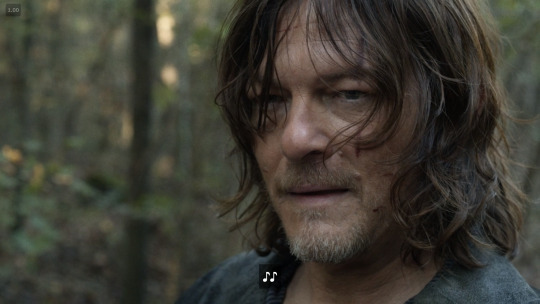
So let me start by saying this. I’ve said it before, but it bears repeating. The point of the six bonus episodes it retell, symbolically, every facet of Beth’s story. So 10x17 represented Inmates, but also 4b in general. I said HERE that it reminded me of everyone being split into small groups in 4b. But they were also tracking children’s foot tracks (in this case Hershel Jr) which is weirdly specific to what Beth and Daryl did in Inmates.
10x18 retold most of Beth and Daryl’s story through Leah. So there were elements of Inmates, Still, and even Coda in it. But it’s pretty much a play-by-play of Alone. Play. By. Play.
10x19 with Aaron and Father Gabriel can be called a retelling of Still. They get drunk. Playing drinking games. Play golf.
10x20 is all about Grady recalls, with the imprisonment theme and all.
So, where does that leave 10x21? As with all of them, there is lots of symbolism I’ll point out, but it’s kind of a scene by scene retelling of Them. I know others may go through it in more detail to show the exact parallels, so I’ll just go over the broad themes today. Tomorrow, I’ll do my normal details post.
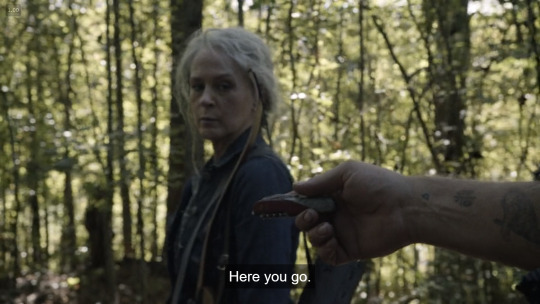
So, it starts with Daryl giving Carol Leah’s knife, which is a retelling in reverse of her giving him Beth’s. She does try to return it to him at the end and he declines, which is super important. I’ll get into that more as we get into the weeds of this, but let’s go over this template first so you can see the broad strokes.
Starting with 10x18 (and I’m following the Daryl/Carol template here, so put Leah aside for the moment), Daryl and Carol get on his bike and leave together. They’re on the outside together for a while, searching for something. Mostly food in this case, though Daryl might have originally been planning to search for Connie. After a time, they come to a place where they spend the night, that has ties to one of their pasts. (In this case, Daryl/Leah.) Then they have an argument. The next day, they part ways.

We’ve actually seen this exact template before, in S5. It comprised 5x02 and 5x06. Daryl and Carol left together in a vehicle (car rather than bike that time). They were out for a while searching for something (Beth). They came to a place where they spent the night that had ties to one of their pasts (in that case, Carol and the abuse center).
The next day, they have a fight. In that case, it was about Noah and Carol wanting Daryl to help him. Not nearly as big or impactful a fight as in 10x18, but the conflict parallels are there. Then, they part ways. The mechanisms, again, are different. In 10x21, they chose to part ways. In Consumed, it’s because the Grady cops hit Carol with the car and took her into the hospital. But I don’t think the reasons matter. Just the basic events.
So what happened next in S5? Daryl went back to get Rick and TF, but then returned to where Carol (and Beth) were at Grady, right? Well, we’ve already established firmly that Dog = Beth. And notice that in this episode, Dog went with Carol. Are we seeing the symbolism?
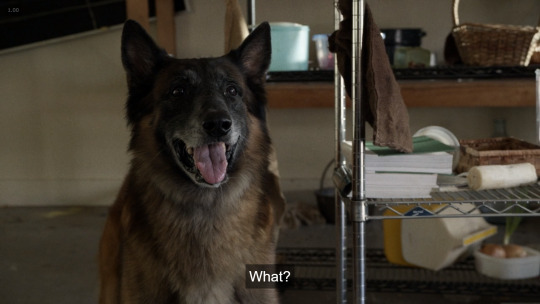
So what follows with Carol is very reminiscent of Grady in some way. Now, unlike Princess, they can’t actually have Carol imprisoned here, because it wouldn’t work for where they need her to be in the story going into S11. So it’s all going to be symbolic.
Carol/Dog/Rat:
I said a few days ago that Rat = Beth. Think of it this way. Rat was minding his own business when Dog suddenly attacks him. So you could see that as Dog and Rat kind of being synonymous symbols. Actually, if we want to get really granular, Rat was in Daryl’s room. We’ll ignore the obvious romantic/sexual pun and just say it represents that rat (Beth) was hanging out with Daryl. Then someone tries to kill Rat. In this case, Carol.

We even have rat getting caught in Carol’s trap (Beth being kidnapped and taken to Grady) but escaping. Then Carol traps Rat in the wall by plugging up the way in with the scarf.
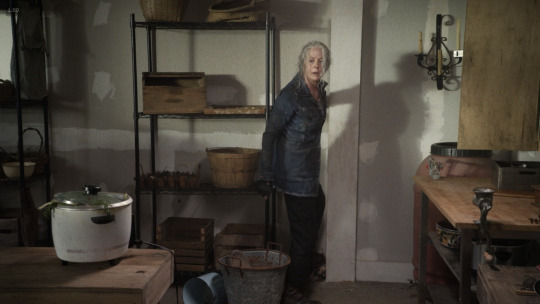
At that point, Rat is not only trapped, but kind of entombed behind the wall. And Carol can’t see Rat. (What is not seen theme.)
Now, in terms of Carol herself, I’ll talk about what they said on TTD, because it’s very helpful in deciphering all this. But in terms of the symbolism, we think what she does here probably equates to stuff that happened during the missing 17 days and whatever role she played in leaving Beth behind. Because of that, it’s kind of hard to pin down.
Other clues? Dog = Beth right? And not only is Dog present with Carol here, but he even watches over her while she sleeps, same as Beth did while Carol was unconscious at Grady. And Carol is definitely a “prisoner” of her own past and her own mind here. She’s clearly obsessing about things like Rat and soup and the scarf because she can’t “fix” bigger things in her life, like her relationship with Daryl or that Connie is still missing and that’s on her. I’ll talk more about this theme in a minute.
Daryl/Bike/Walkers:
Daryl’s arc here is also chalk full of symbolism that I don’t think I’ve even entirely pinned down, yet, but I really love it. In Daryl’s case, the bike breaks down, right? There’s a hole in one of the hoses that’s leaking stuff, which makes the bike stall, and he has to go find the tools and resources to fix it.

So, here’s how we’re interpreting this: bike = Beth. Why? Well, I think we can all get behind music box = Beth, can’t we? (If not, I don’t know why you’re following my account.) And remember that I said this was a replay of Them. Just as Daryl fixed the music box in Them,

he fixes the bike here.
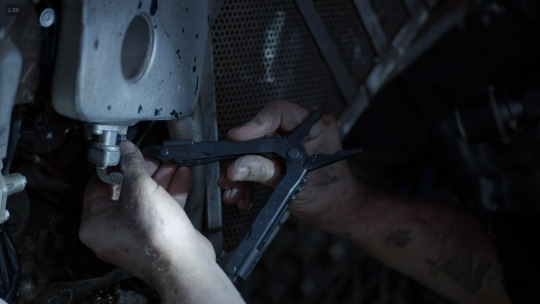
The train tracks are another clue. He takes the bike to the tracks and leaves it there. You know I think train tracks are indicative of Beth’s path, but I’m also sure they’re a multi-layered symbol with many meanings.
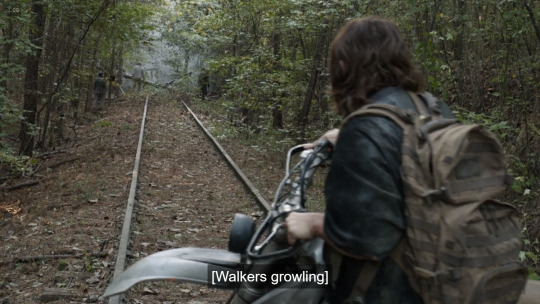
In S4, Beth was the only one who didn’t actually follow the tracks. She crossed them. Daryl did too, initially, but he later followed them to Terminus with Rick and Michonne. Beth was the only one who never did that and therefore never ended up at Terminus. Her path would be completely different. We saw hints of this symbolism in 6x08, when Daryl crossed train tracks on his bike after being hurt, and we see the same thing here.
The “hole” in the bike hose represents Beth’s gunshot wound, dripping blood. Daryl leaves the bike to go look for something to fix it with. So, this part is kinda non-specific.
You could say leaving the bike where it was in the woods = leaving Beth behind. But where does he search for the part?
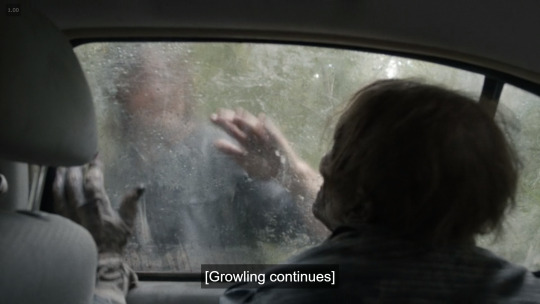
In a group of 3 cars with a walker inside, which is also indicative of where we think they left her. So, this whole sequence kind of points to the missing 17 days and leaving her behind. With the bike being “dead,” (read: unconscious for a human) Daryl pushes the bike manually, which may parallel him carrying Beth.
My fellow theorists and I discussed the idea that back in S5, Daryl didn’t have the “tools” to fix Beth after she was shot, or the understanding not realize she wasn’t really dead. But at some point, he will. We don’t know what the “fixing” point refers to overall, or how it will manifest in the show. It could be lots of things. Literal, medical, emotional. Who knows? But it’s interesting.
Now, on the one hand, this points backward, to those missing scenes. But I always say every callback doubles as a foreshadow. After all, if Daryl had “fixed” Beth during those missing 17 days, she wouldn’t be missing and presumed dead, right? And in Them, we see him fix the music box, and the next scene is Aaron showing up with “good news” and the music box waking up. Clearly that didn’t happen with Beth in S5. So at some point, this shifts from a callback to a foreshadow of what will happen when he actually finds her again.
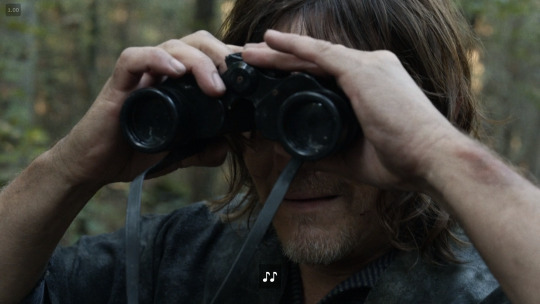
Now, in order to understand (as far as we can) this symbolism, I will have to get somewhat granular. Because the whole sequence is very strange. Daryl stops the bike on the tracks and looks through his binoculars. (Binocular Theory). It doesn’t really show us what he sees or what he’s trying to do, but I think the idea is that he sees the military walker and is hoping to find a smaller knife on him that he needs to fix his bike.
Imma come back to the knives, because they’re a theory all their own, but let’s examine the events first. He leaves the bike on the tracks and moves forward. Now, I had to watch this several times to understand it. I think the idea is that there were walkers on both sides of the tracks that hadn’t noticed him. They’re milling around but not focused on him. So he’s hoping to slip, unnoticed, between them. Unfortunately, he snaps a twig under his foot and they all turn toward him.
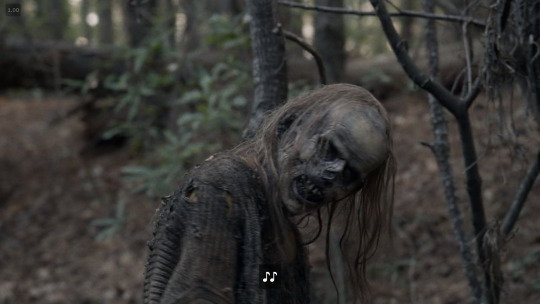
Everyone’s been asking about the Beth walker. She’s definitely here in this scene. I almost wonder, if she represents Beth, if it’s supposed to be that she’s there, close by, but he’s focused on something else, and doesn’t notice her. I kept thinking he would kill this walker, but he never does, and I think that’s significant.
Also, these military walkers probably represent the CRM. So, for example, this may represent a future storyline where Daryl has a run-in with some members of the CRM. He manages to get away here, which probably means during that future interaction, he’ll get away, too. But he may not realize Beth is with the CRM. So she’s there, hanging around, but he’s too focused on other things to notice.
(Disclaimer: I’m not saying this is exactly what this scene foreshadows. As always, the details will probably be wrong, but it’s something along these lines.)
Now, there are a lot of weirdnesses in this scene. He suddenly starts limping, for one thing. He wasn’t limping before this, and he doesn’t have the limp when he returns to Alexandria. So to me, that screams that this is a foreshadowing of something we haven’t seen yet. When whatever this sequence foreshadows plays out, Daryl will probably be dealing with an injury of some kind.
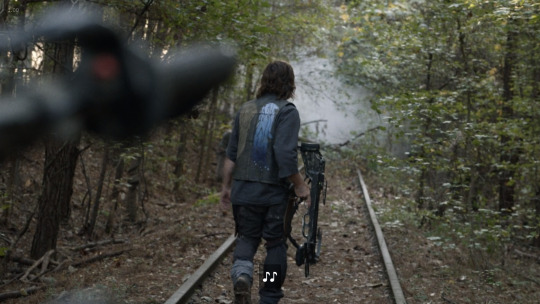
He hurries toward a ravine where a military walker is caught in a tree. (Tree/Trunk symbolism anyone?)
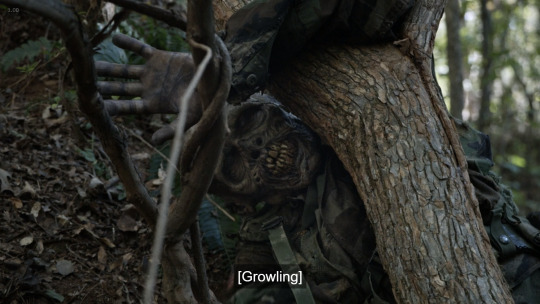
So, in terms of this episode, he obviously saw the military walker and hoped this dude might have a knife on him that Daryl could use to fix his bike. That’s what he’s up to here. And it turns out, he does.
Symbolically, it’s a whole other ballgame. In terms of the binocular theory, I always thought Red Poncho Guy, who Daryl and Aaron looked at through binoculars, represented Beth. Both because of the red poncho (red garment in Beth’s cell in 4x01) and because he was taken by the Wolves. It’s possible the Wolves are the symbolic antecedent of the Reapers or the CRM. Or both.
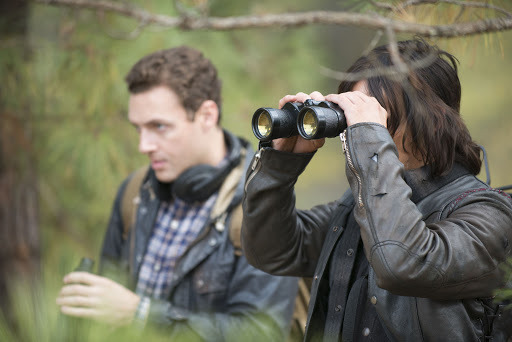
So, I think this whole sequence where he walks along the tracks, past the Beth walker, and then interacts with these military walkers that probably represent the CRM, is a foreshadow or future telling of how he’ll find Beth. Because of the limp, maybe he gets injured and the CRM take him somewhere—like they did with Rick—and that’s where he find Beth.
How is that represented here? He finds the knife he needs to fix the bike.
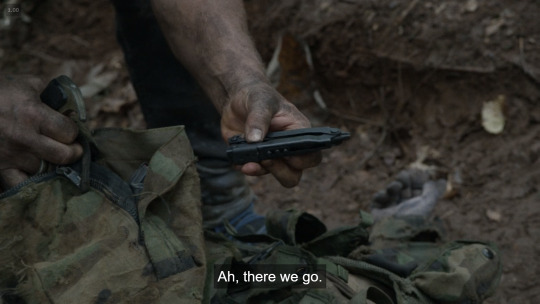
And again, we don’t know what the “fixing” will mean in a literal sense when this plays out. Maybe fixing is just finding her. Because that will “fix” the hole she left in his heart when he lost her. Maybe it will mean something else.
But the knife itself is important. Why? Because it’s…kinda cooler than Leah’s knife? It’s bigger. It does more stuff. It’s a better tool and a better weapon. It’s kind of life Knife 2.0. And how many times have we talked about how when Beth returns, she’ll be tougher, stronger, a better survivor. She’ll be Beth 2.0. They even said that in the TTD after Still. Remember the phrase they used? “Raised by Hershel, trained by Daryl, meet the new Beth Green.”
So, remember that Leah represents everything that came before in S4 and S5, so her knife then represents the old Beth. The one that died at Grady, emotionally if not physically. Knife 2.0 then represents the new Beth as she’ll be when Daryl finds her again. And where he did find Knife 2.0? With the military/CRM walker.
See what I mean?
A couple of details that parallel this to Them: When Daryl fights the military walker, he slides down into a dry creek bed. There was a dry creek bed in Them. There’s also a small bridge behind him (Bridge Theory) with a circular opening for water to pass under it. (Beth = Water.)
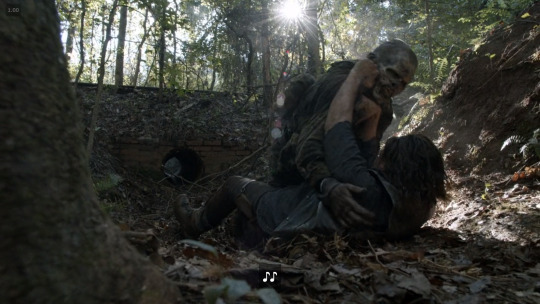
When he gets out of the ravine, he sort of goes a different way and all the walkers that were coming after him just sort of fall into the ravine. That’s exactly what happened in Them. Remember? TF was on the bridge and they would wait for the walkers to come close and then jump out of the way so they all fell off the bridge? Yeah. Replay of Them.
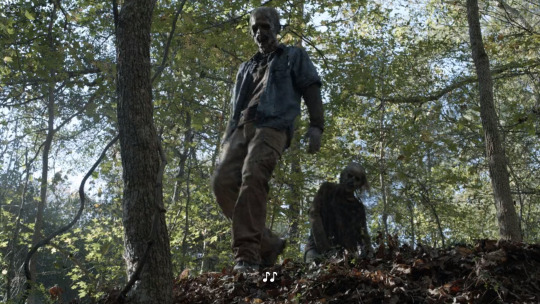
So then Daryl goes to fix the bike and two more military walkers come at him. Yes, two. At first, you’ll probably only see one because they show it weird. But there are actually two. He pulls ammo off one and food rations off another.

What does that mean? I don’t want to go into too much here, but I think it’s just all part of the CRM story arc, which we won’t truly see play out until the spinoff. I think this lack of food they’re dealing with will continue, and at some point their water will become undrinkable. So, it won’t be a matter of grabbing Beth and Rick and running back to Alexandria. They’ll all die without the CRM’s resources. (Hence why Daryl finds food and ammo on these walkers and is like, “nice.”) Much like with Negan/AOW, they’ll have to find some way to integrate and all live together peaceably. Which is also what Rick’s confrontation with the Governor in 4x08 foreshadowed.
Next clue. It takes Daryl a while to fix the bike and it gets dark before he’s done. I totally didn’t catch it the first time until @frangipanilove clued me in, but we hear a wolf howl in the distance. The subtitles confirm it is a wolf, not a coyote or dog, and Daryl even looks over his shoulder as though acknowledging it. So to me, that’s wolf symbolism, and shows that the Denise/Wolf template will be in play when Daryl finds and ‘fixes’ Beth.
It’s actually way more complicated than that, but this is part of that second rabbit hole I mentioned this morning that I won’t be posting about until after ep 22.

Repeat of Still Theme
Okay, the only other thing I want to draw your attention to today (Details tomorrow) is that there is a theme of letting go of the past in order to move forward. And that’s very much a Still theme. Beth and Daryl burnt down the moonshine shack as a symbol of letting of their pasts and moving forward. And we see that same thing here.
People are going to say this is boring bc Carol makes soup and chases a rat around the kitchen, and Daryl fixes his bike. And on the surface, they’re right. But I’ve already explained the significance of him fixing the bike.

For the rest, not until Carol gave up on the rat did it actually get free and get out of her hair. And I think the scarf represents something that really couldn't be saved, and wasn't worth her time, but she started to obsess over it. She couldn't control or fix the bigger things in her life, so she's trying to fix small things that actually don't matter much. And when she finally made her peace with that, she threw the scarf away because she didn't need it anymore.
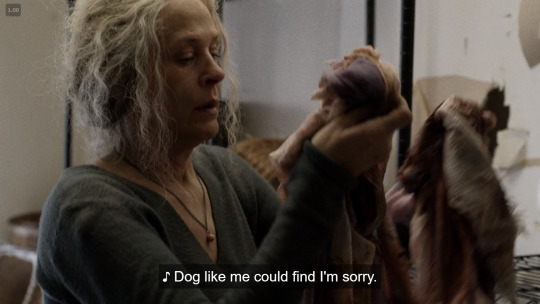
Same with Daryl and Leah’s knife. They actually say on TTD (which I’ll post about in more detail on Wednesday) that Daryl letting go of Leah’s knife and letting Carol have it represents him letting go of Leah. So, we still think she’s mostly hallucination anyway, but even if we’re wrong about that, they’ve pretty much confirmed that the Daryl/Leah thing is completely over.
But think about what we’ve said about Leah. She represents his time with Beth IN THE PAST. He has to let that go in order to move forward. And I think he was always going to have to reach this point, emotionally, before Beth could return.
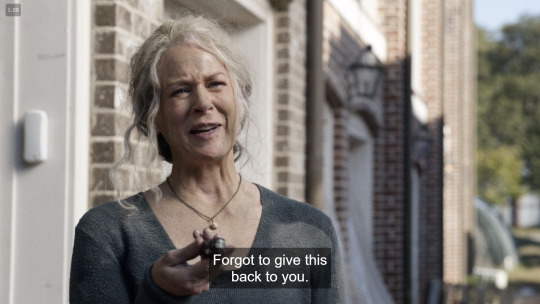
Another way to think about it: just as with Beth’s knife, he probably needed to hang onto Leah’s knife for emotional reasons. It has to do with his guilt and trauma and grief over whatever happened. Now, I don’t think they wanted him to give Beth’s actual knife to Carol because that will probably figure in the plot eventually, but this is a symbol of the same thing. The knife, like the hallucination of Leah, is something he created to get himself through the hardest time of his life. Now, he’s past it, and letting it go. Just as Beth taught him to do in Still.

It's about letting go of small things in order to move forward.
So, I’m really looking hard at knife #1 (Leah’s) vs. knife #2 (leatherman that he gets from the military guy). Because, I think just as we always talk about how Beth from S4/S5 was not only younger, but naïve, innocent, less mature in her character development, etc., when she comes back, we know she’ll be tougher, more badass, Beth 2.0, etc. right? Hence, she just changed.
And I think the knives represent that. The old model being left behind (by Daryl) and he finds the newer, better knife, which represents him finding the new Beth. Hence the train tracks and the military walkers (CRM). And incidentally (haha not so much) we do see the Beth walker in that same sequence where he finds the knife.
In Still, we learned he has to let his past go to move forward, and he’ll have to let his past go to find Beth. So again, I’m wondering what the knife will represent that he gives Carol when they part before he actually runs into Beth.
I did have one idea: maybe it’s not a tangible object. Maybe he gives her the truth about Leah. That she’s a hallucination. He finally admits it to her, and then later realizes he can’t function without it (just like he needed the knife). But he’s gonna need to let it go and find something better before he actually finds Beth.
And I actually think the scarf/leatherneck thing works with this. I mean, Leah wore the fox scarf. So in that way, it may function similarly to the knife. Something that needs to be let go to move forward, even if it’s kinda painful. And Carol throws away the scarf in this episode.
I was thinking about when Carol went to see him the last time in 10x18, she gave him a scarf, right? But it was kind of a token gift. He didn’t look particularly pleased with it. And she admitted it wasn’t the real reason she was there. First she said something about how she shouldn’t need an excuse to give him a gift, but then she says, “okay, the REAL reason I’m here…” And he took it, but you could tell he was kind of like, “okay, whatever.” And that’s similar to the knife here. She offers it to him, but he doesn’t want it. So yeah, at least in this respect, I think scarf and knife are somewhat synonymous.
Okay, I’ll stop there for today. I have TONS more to say about the specifics and TTD, and plenty about where all this is going. But I’ll leave you with that today. Thoughts?
#beth greene#beth greene lives#beth is alive#beth is coming#td theory#td theories#team delusional#team defiance#beth is almost here#bethyl
18 notes
·
View notes
Text
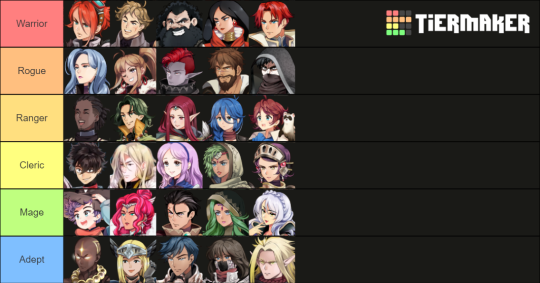
Dark Deity Pre-Release Character Opinions
This isn't actually a tier list, but someone helpfully created a template for this game and it's as good a way as any to do a little visual showcase for this cast. Characters are listed by their class sets, which are fixed but offer a nice variety in terms of promotion options. My opinions on each are as follows, from left to right in each row. Most characters have introductory profiles written up on the DD subreddit, if you'd like to check them out yourself.
Warriors
Alexa
You know those buff female blacksmiths in Echoes and Three Houses that some people wish were playable characters? That's pretty much Alexa. Can't say I'm too hyped about her myself, but warrior + tomboyish female character will do that for me...or not do it, I suppose.
Benji
Seems to have been written to become a meme, and I still can't decide whether that's clever or stupid. Kind of like Raphael only with a bigger emphasis on training than on eating, and with brotherly devotion replaced with brotherly angst that might theoretically go somewhere if the character isn't reduced to being a goofy joke all the time.
Fenton
Doesn't have a character profile, so as far as I know he's just a generic dwarf because DD swaps out its inspiration's loli dragons and other vaguely fetishistic shapeshifters for the two most cliché non-human races in Western fantasy. I wonder whether his VA will voice him with a Scottish accent, to go all in on the (ironic?) laziness. There are a handful of elves in the playable cast, but Fenton is the only dwarf so for better or worse he's representing.
Helena
She's the embodiment of the FE exotic swordswoman archetype, but curiously DD seems to have turned that broad ethnic brush inward. Helena's last name is apparently a Japanese verb, her art shows her with a spear (as in the association of the naginata with women), and she studied and trained in a monastery that seems to blend elements of Buddhism and Shintoism. Not sure how all that fits into the larger setting yet, but at this point she's still got more background development than Petra.
Irving
Our Hero, the one front and center on the cover art. He sounds a bit on the blander side as far as lords or lord equivalents go, with his most promising hook for me being his established friendship with Garrick (see the ranger section). At best I can hope for a bit of a romantic friendship dynamic, although they sound a bit rougher overall as they're military academy schoolmates I wonder why DD went with that instead of lordlings of different territories.
Rogues
Brooke
Looks like Camilla; has a backstory like Niles. Cleavage aside though the sexual element of both is toned down here, and there might be some sapphic bodyguard shenanigans to be had as her current employers are a pair of highborn sisters further down this list.
Cia
For some reason she reminds me of Tressa from Octopath Traveler, only bustier and a bartender rather than a merchant. She's still just a small town girl with big city dreams, and this being a tactical war game following those dreams will inevitably involve stabbing people.
Corvan
Hard to judge him at the moment, as his profile was only the second written and so isn't terribly detailed. He's a moon elf with scholarly interests, apparently. Still, as of right now he's the only rogue who doesn't slot loosely into either a ninja/assassin or pirate aesthetic, so that's kind of neat. Also, he's one of several characters to have FEH-esque beach fanart made of them already, so clearly someone's into elf twinks.
Ford
A former officer at the military academy Irving attends and a smuggler who dotes on his niece, Ford has major dad energy. Per developer reveals he's also bi, and as I mentioned before I'm totally fine with that. More bear sex, please - but what guy in this cast would hop in the sack with Ford? Only time will tell. His personal skill makes him extra dodgy, which combined with the mug of booze in his art makes me think of WoW brewmasters who dodge-tank through the power of being wasted.
Wren
Like Brooke, he's an assassin from a foreign nation - in his case the same one as Helena so presumably he's a not!Japanese ninja. I'm not really feeling him at the moment. What is it about Hao'Fen (the city/territory he and Helena come from) and massive families? That comes up in both their backstories.
Rangers
Caius
I feel like this is the third or fourth character to grow up in some slum or other; at least they've all been in different towns so far. The relative rarity of noble characters is certainly different from FE, but it reduces the political stakes which leaves me wondering a bit about the story. Anyway, Caius is a small town desert hunter who learned how to make arrows out of animal bones. How aerodynamic is bone, I wonder?
Garrick
Irving's BFF and seemingly the Hector to Irving's Eliwood, only with more flirting (his intro doesn't specify that Garrick is flirting with women, but I'm not going so far as to say that indicates anything). He's the academy headmaster's son, with a strained relationship with his father for some of that hotheaded lead tension. Notably, his VA is the one I'm most familiar with in this cast, as he's the voice of Revali from Breath of the Wild as well as love interests in two different erotic gay dating sims I've played. In other words, I know what this guy sounds like making awkwardly simulated sex noises...and I have no idea what to do with that information.
Maeve
She's a half-elf with a very storied background, so much so that it's all rather hard to follow her exploits when little of what's being described has been fully revealed yet. I'm expecting her to be a mid/lategame recruit, unless she's dropped in early on to reveal that (sun) elves exist or something.
Rose
Imagine if Bernadetta were a commoner, although we can only hope they'll be less screaming. Alternatively, Neimi without an obvious boyfriend. She won the beach contest so now she has official swimsuit art, which I guess makes her a top-tier waifu in the eyes of players who care about such things.
Sophia
A ranger in the "has animal companions" sense, although whether that will come into play mechanically aside from her personal skill - Butter the ferret can attack with her! - remains to be seen. Her preference for the company of animals is explained by a lack of social graces, so prepare for klutz-related humor. Of note to those interested in F/F is that her introduction specifically brings up her connection with Sloane (see the mage section) and how close the two of them are.
Clerics
Faust
Doesn't have a profile yet, so not much to go off other than his decidedly unhinged look. The cleric class set does feature some darker-flavored options, so presumably he's more naturally aligned with those. His VA was announced to be the YouTuber behind So This is Basically Fire Emblem and other similar videos, so I'm picturing a kooky and somewhat demented Henry type.
Lincoln
Also lacks a profile at time of writing...clerics get so little love. The Discord has identified him a bland blond paladin sort, but as we know from the likes of Perceval and especially Dimitri that doesn't necessarily mean he'll be boring (or not gay).
Maren
The soft-spoken healer type, and also a childhood friend of Garrick although her intro sibling-zones him but then this game is inspired by FE so who knows if that'll stick. She may have some interesting thoughts on the theology of the setting, as there seem to be several faiths and she's said to have a complicated relationship with her own. I will be utterly shocked if she's not either Irving or Garrick's eventual love interest.
Samara
One of two princesses of the country of Aramor, which appears to be loosely inspired by the Middle East. Heaven help us if the Khalidstans ever get wind of this game. Unfortunately aside from her bond with her older sister (in the mage section) and the knowledge that Brooke has been hired as their bodyguard there's not much to Samara at the moment. Hopefully the clerics all do some comparative theology in their bond conversations, and this isn't like Sacred Stones where none of the clergy characters from different countries ever compare notes. The succession crisis involving Samara and her sister vs. their less-loved cousin the king's son might be a major plot hook? It's still too early to tell.
Vesta
Much like Maeve her backstory has entirely too much going on to really follow at the moment. Basically she's a human who grew up in a sun elf city because Reasons (seriously, I don't know what they are) and was called to a clerical vocation and also something about taking a journey. Has an unfortunate case of silly boob armor, which unlike a certain other character probably won't be rectified this close to release.
Mages
Alden
Maren's precocious younger brother, also basically Ricken up to and including the comically oversized hat. As a unit he follows the tradition of Donnel, Mozu, and Cyril of having a personal skill that buffs his stat gains, so it's safe to say he's a growth unit. At least he'll probably join early.
Liberty
Comes with dead brother angst and a connection to the "aspects" system that will hopefully make more sense once I've played the game and know how it functions both mechanically and from a storytelling perspective. Otherwise she looks to be a busty older - as in, not a teenage - mage in the vein of Calill.
Monroe
Got the first ever character profile, so it's really short. He's the son of a duke and sounds like a bit of a snob, albeit one that can make explosions happen to back up his haughtiness. He's got some scarring around his eye that surely must come with a story. Someone also made featured fanart of him in Heroes summer banner style, so I guess he's got somebody horny already.
Sara
Samara's half-sister, with comparable fantasy Middle Eastern flavoring. Has an interest in discovering magical artifacts and being a just ruler in the event she winds up on the throne (so, almost definitely), and she and Samara travel around with the assassin Brooke as their bodyguard. There's maybe some lesbian possibilities there? Either way, Sara has enough development where I could see her as a major supporting character.
Sloane
Comes with a genuinely fascinating backstory involving manipulative double-crossing parents, an education in the cruelties and deceptions of social life (reflected in her personal skill), and disinheritance - and yet it's all likely to be overshadowed because she may go down as DD's equivalent to Fates's face-touching. Her initial art is even more revealing than Camilla's, and while the developers later gave her a more modest redesign after negative feedback I get the feeling that this controversy may live on. Her introduction mentions her hunting for both heirs and heiresses and she's now been linked to Sophia, so safe to say she's another confirmed bi character.
Adepts
While the other class sets are standard fantasy fare adepts require a bit more explanation. They have innate magical abilities and appear to be feared and distrusted most places in the setting. Functionally they remind me of adepts from the Golden Sun series, if anyone is familiar with those games. The classes in the adept group tend more toward physical/magical hybridization than those of other sets, so that will probably be their mechanical niche. Oh, and their default weapon type is lances, which is a plus in my book.
Aurima
Along with Caius and the royal sisters, he's another one from the desert nation of Aramor. An arena fighter who got touched by a god in what I assume was a non-sexual way and came out of it with a new appearance and adept powers. Also, he's confirmed to be over 40 - how often do you see that in games like this?
Bianca
Looks like a more carefree Mathilda from Echoes. She's a ranking officer in the Delian army which sounds like it'd sit uneasily with her adept powers. Her profile describes Lincoln as her close friend, which is still about the most we know about him at this point.
Elias
This guy's writing plays more into the fairly standard coding that comes with adept powers, as we know they manifested shortly before he was going to confess his feelings to a male paramour and afterwards he was forced to flee his homeland and wander the world. He also spent time among dwarves, so insert short bear jokes here? In the present he's attached to Cia in what seems to be a platonic way; maybe she's a fruit fly, or maybe she just likes having a friend who can light drunken assholes on fire? Elias is definitely into guys, but I would still be a little surprised if he turned out to be totally gay as that's such a rarity in these sorts of things.
Iris
Oof, another lengthy and rough backstory. Iris had better parents than Sloane, but she also had to deal with permanent facial scarring (hence the mask) after a bandit kidnapping and the stigma of manifesting as an adept pretty much eliminating the prospects of her making a good political marriage. Also, she and Elias both come from Neullais, which is prominently featured on the continental map on the DD subreddit but doesn't seem to come up all too often in backstories. I think it's a not!France? Hard to tell.
Thae'lanel
A World of Warcraft blood elf, flowing anime hair and apostrophe'd name and all. I like WoW so that's not terribly grating, but as he has no profile yet there's little else I can say. Thae'lanel is mentioned in Maeve's introduction as a member of a sun elf group called the Exiled, which I'm guessing is tied to his adept status in some way. He and Maeve form yet another adventurer/bodyguard duo.
12 notes
·
View notes
Text
Narrative Mirror Characters in Supernatural – An Overview for the Uninitiated.
Mirror characters have always been a classic story telling device. The purpose of a mirror character is to reflect on the main characters journey and emotional state and to provide lessons for the main character to learn. Mirror characters in TV and movies can also be used for foreshadowing purposes and encourage the audience to question the main characters path.
A famous example would be Frodo Baggins and his narrative mirror Gollum in The Lord of the Rings. Gollum is a dark mirror for Frodo in that he represents everything that Frodo could become if he succumbs to the power of the One Ring. Frodo’s present is Gollum’s past as Smeagol, and throughout the books Frodo becomes more and more aware of his fate as he grows closer to Gollum/Smeagol and makes the decision to try to save him as a reflection of his desire to save himself.
Narrative mirrors are everywhere and widely used in all forms of storytelling. To deny them, is to deny basic storytelling tropes. Sometimes the narrative mirrors are extremely, painfully obvious, and other times they are quite subtle and have only a very minor meaning in the greater story.
Supernatural is a series which has used narrative mirror characters quite extensively throughout its long history. It frequently uses mirror characters to provide an additional layer to the emotional journeys of its lead characters to encourage emotional growth. Supernatural also often uses mirror characters to highlight unspoken main character storylines which support subtextual themes as well as foreshadowing potential future plot outcomes.
Supernatural relies so heavily on its narrative character mirrors, that recently in episode 14x04 Mint Condition it gave its viewers a textual lesson on character mirrors straight from its lead characters mouths:
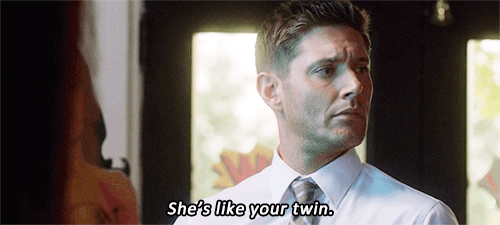
Gif Source: (x)
DEAN (Pointing at Samantha): She’s like your twin.
[SAM pushes his hair back just as SAMANTHA does the same.]
SAM: What? What are you talking about?
DEAN: Soft, delicate features, luxurious hair. She’s like your wonder twin.
SAM: Yeah.
[A man, DIRK, is crouching in front of the comic book stands picking up comics. He has a lollipop in his mouth. SAM points to him.]
SAM: Well, okay, if that’s me then that’s you over there.
DEAN: That guy?
SAM: Yeah.
DEAN: Yeah, we have zero in common
(The scene then proceeds to show just how much Dean has in common with Dirk)
Following this fun scene, the episode continues to show how much Sam and Dean have in common with their mirror characters in many ways, including a moving moment between Dirk and Dean in which Dirk talks about how important his friend Stuart is to him. (Stuart who was first introduced in this episode wearing a tan trench coat similar to the classic coat worn by Castiel – Dean’s best friend).
From this blatantly obvious in-show commentary, we can infer how the Supernatural creators like to present their mirror characters and how we, the audience, can keep a look out for them. The key indicators are as follows:
Similar clothing - Character clothing choices are very important in this show. The brothers are almost always dressed in plaid and what Castiel would probably call “lumberjack chic”. Castiel always wears a tan trenchcoat, formal attire, white shirt, blue tie. His mirrors are pretty much the easiest to spot. Arguably any side character wearing a tan trenchcoat is a mirror for Castiel.
Siblings – Where side characters are siblings, they are mirrors for Sam and Dean.
Parent/Child pairs – Less common, but also often a comment on Sam and Dean’s dynamic, Dean being the parent to Sam.
Immortal characters with a sympathy to humanity – usually a Cas mirror.
Tastes/interests – Like with Dirk, if a side character appears who the main characters bond with over mutual interests, the chances are they are a mirror for the main character in question.
Storylines; depending on overarching season plots – less obvious, but sometimes the most interesting. Characters that appear in standalone episodes that have an emotional tie to the mytharc plot of the season usually serve to give lessons to the main characters. Those characters will stand in for the main characters when dealing with their own emotional turmoil, which will usually be similar in theme to the emotional turmoil that the main characters are going through. Consider Ed and Harry from 9x14’s #Thinman episode - such a blatantly obvious Winchester mirror that it should need no explaining here.
By taking all these various indicators into consideration when watching any episode of Supernatural, it becomes rather easy to spot the character mirrors and depending on the actions and plot purpose of those mirror characters, we can usually conclude their purpose and the connection to the overall mytharc, or in some cases character development plot.
I’m about to pull out some big examples so you can use those as templates to go forth and find the mirrors! But my main point in this post is to argue that meta writers aren’t pulling this stuff out of our asses. Character mirrors are a story telling technique that is used frequently and with clear author intent. Don’t ever let anyone tell you that you are seeing things when you believe that characters are meant to be mirrors. It is far more likely that they ARE intended mirrors than not.
I recently came across these tweets on Twitter:
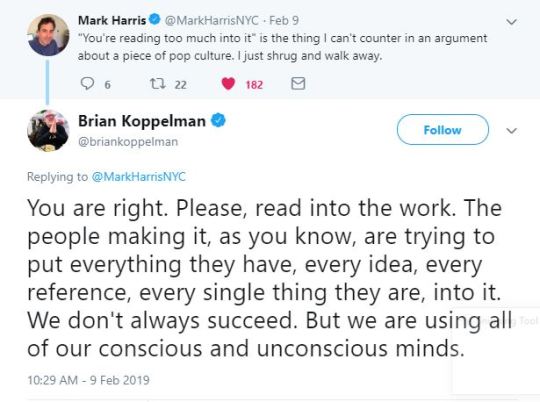
Mark Harris is a former Entertainment Weekly executive editor and author of several books on Hollywood and the film industry.
Brian Koppelman is the co-creator and showrunner of the TV show “Billions” and has worked in the TV and Film industries for over two decades.
I would hazard a guess that both of these individuals have a greater authority on the inner workings of TV show production than YOU or I or anyone else in this fandom about to scream those immortal and highly ridiculous words “yOu ArE rEaDiNg InTo ThInGs!”
But by all means, if you are going to disregard my post as nothing more than a “crazy” fan trying to claim author intent where there is none, perhaps you could first take a look below the cut, because these mirror characters in SPN are hardly coincidence, and the general motto to run by is that if some characters are definitely mirrors, then the chances are that wherever you THINK you see a character mirror, and it makes logical sense, the INTENT was for you to see a character mirror all along.
So therefore, never disregard a fan interpretation of a narrative character mirror when they see one.
If you do, you are going to look like a huge jackass.
Please keep reading for glaringly obvious Destiel character mirrors along with some nice brother character mirrors for comparison. We ain’t kidding around folks.
First of all, lets consider some examples where Supernatural has used narrative mirror characters specifically to highlight Sam and Dean’s emotional growth.
A recent and very obvious example is from 14x12.
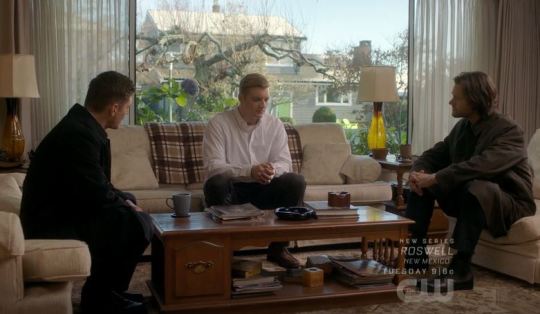
The brothers interview Eddie, the twin brother of a murdered man in a case they are investigating. Eddie is distraught by his brother’s murder, and he says the following:
“I can’t believe he’s gone. We were close. Best friends. Alan always said he was my big brother, ‘cause he was born first. By, like, four minutes. Losing him is like losing a part of myself. I never knew it could be this bad.”
In this situation, Eddie is a clear Sam mirror character, because his emotional response to his brother Alan’s death is exactly what Sam’s would be if he were to lose Dean. Dean, in this scenario, is the one learning the lesson. He is having to witness through a character mirror the pain that Sam would go through upon Dean’s suicide. This reflects the current mytharc plot in which Dean has chosen a suicide mission of locking himself away with the archangel Michael in order to prevent Michael’s escape.
This is a simple mirror which specifically relates to the theme of the episode. However, other character mirrors have a wider lesson in mind. Another recent episode that used character mirrors for the brothers was 13x12 Various and Sundry Villains.
In this episode, the brothers come up against a pair of villainous witch sisters. The sisters are determined to bring their mother back from the dead and will stop at nothing to succeed. The sisters are dark Winchester mirrors in that they symbolise the lengths the brothers will go to in order to save themselves and their family – putting their own goals above the safety of the world. This episode took place during a season 13 mytharc plot in which the Winchesters own mother Mary was trapped in an apocalyptic universe and the Winchesters were looking for a way to save her (and Jack) regardless of warnings from Death herself that no good would come from jumping universes.
It was also a wider commentary on the Winchesters own toxic co-dependency – a theme that has been running within the subtext of the show since Season 8 which portrays the brothers co-dependent relationship as a negative force in their universe and something that they need to break free of – a theme which has been building quite nicely in these later seasons.
The episode 13x12 ends with the witch sisters horrifically murdering each other whilst under a spell in a scene which symbolically shows just what could happen to the Winchester boys if they don’t free each other from their own toxic relationship.
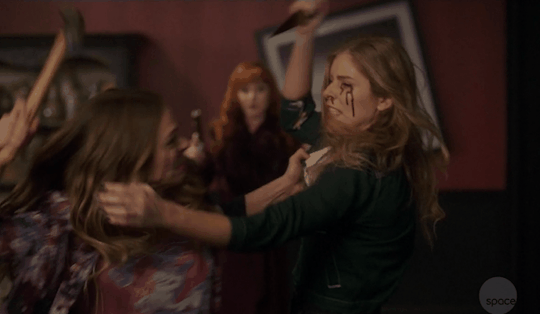
This was a prime example of character mirrors have a deeper message in terms of their relation to the main characters and their overall character journeys on the show.
Sam and Dean have had mirror characters established in the show since the early seasons. One obvious example was in 1x18 Something Wicked This Way Comes which prominently features a young boy called Michael who feels responsible for his little brother Asher. Michael is an obvious Dean mirror used to emphasise Dean’s loss of innocence at a young age due to the boy’s early introduction to monsters by their father.
Many of the early season character mirrors were used to provide backstory for Sam and Dean such as this one, or to provide dark foreshadowing (like used with Frodo and Gollum) for Sam particularly with the “Special Children” throughout seasons 1 and 2.
In the later seasons, character mirrors are more likely to be used to either provide Sam and Dean with emotional lessons, or highlight their co-dependency as a negative force.
See, its quite simple so far right? Would you actually deny that these characters were Winchester mirrors? You can possibly argue with my interpretation, but you can’t really argue against the mirrors themselves, that much is obvious.
Now is where it gets interesting. Because whilst you may have no problem seeing mirror characters for Sam and Dean in the show, would you feel the same way if I was to present you with an EVEN LARGER mountain of evidence for mirror characters for Dean and Cas?
Another frequent use of character mirrors within the show in the later seasons is to highlight a potential romantic partnership between Dean and Castiel. This is a controversial opinion and one many viewers of the show either ignore or adamantly deny. However, arguably you can’t pick and choose your meta in this show. If you agree with one set of thematic mirrors, you must surely admit to the same filming techniques being used elsewhere. If mirrors exist between Sam and Dean, they must also exist between Dean and Cas, and sometimes those mirrors are just as blatantly obvious, if not more so.
One prominent example (and probably the most obvious) comes from episode 9x20. Written by the current showrunner Andrew Dabb, this episode was an attempt at a spin off show with a completely new set of characters. One part of this episode included a love story between monster characters David and Violet.
Please refer to this post: http://bluestar86.tumblr.com/post/178577156431/i-cant-recall-where-but-i-read-somewhere-that-a for further detail about this character mirror. Because it’s so obvious its laughable.
The basic mirror is that David is Dean. He is the son of a powerful monster family in Chicago who is pulled back into the war when his brother Sal is murdered. “David” = Dean, “Sal” = Sam. Get it? That’s one clear mirror. The back story alone is obvious enough.
Violet is the daughter of another powerful monster family, one that is actively antagonising the others and supports the war. She spends most of the episode wearing this:
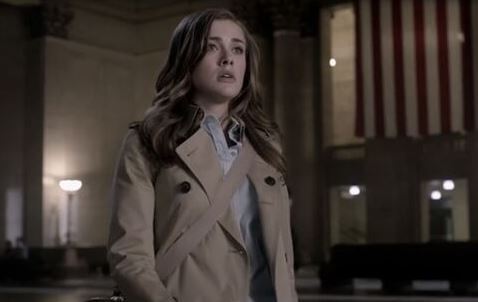
Violet is clearly our Castiel mirror. A daughter of a troublesome monster family that wants to start war, but who tries to prevent that because of her love for one of the other families sons? Its Romeo and Juliet but it is also very Dean and Cas.
The turbulent relationship between David and Violet is told using lines previously spoken between Dean and Cas word for word, but in an obviously romantic way (because heterosexual romance is irritatingly obvious even when using lines previously given to “just bros”). Seriously, go read the linked post and just TRY to deny this mirror.
One of the more recent obvious DeanCas mirrors in the show comes from season 14 between Mary Winchester and AU!Bobby. In the episode immediately following 14x04’s lesson in recognising mirror characters in Supernatural Mary and Bobby show up to put our mirror recognition to the test.
Mary has been used as a mirror character for Castiel and vice versa since she was reintroduced to the show in season 12. In terms of the key indicators, she has often been seen wearing a tan trenchcoat, or a general tan coat with white and blue clothing (her clothing is often coded for Castiel) as well as her emotional journey being tied to his in her struggle to find belonging among her family.
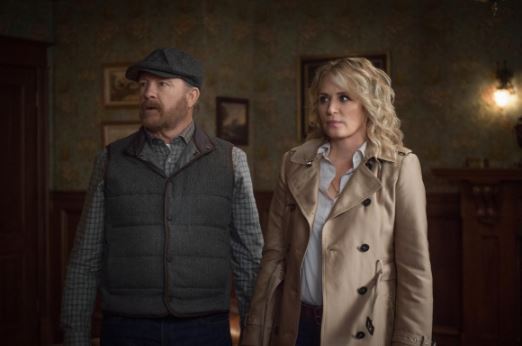
AU!Bobby is a Dean mirror. His story very closely compares to many of Dean’s storylines over the years, including Purgatory and being traumatised by the loss of his son (a canonical fact being that both Sam and Dean acknowledge that Dean raised Sam and was practically his only parental figure).
The romance between him and Mary is still pretty much completely subtextual, and yet people still acknowledge its existence. It has been shown through longing looks and conversations with the brothers where Mary voices her frustrations at her inability to break through the supposed communication barriers between her and Bobby (an interesting storyline which compares extremely closely with season 13’s long running miscommunication theme for Dean and Cas.)
Bobby and Mary’s current story reflects Dean and Cas’s especially in Mary’s frustrations to get Bobby to open up to her about his troubled past. There is an underlying message here which indicates Castiel’s own frustrations at Dean for not being more open and honest with him (again this was shown far more subtly as recently as 14x12 in how Dean keeps things from Cas because they are far too painful for him to address). This mirror is practically undeniable, just like David and Violet. Yet both are romantic.
The other glaringly obvious het character mirror pairing for Dean and Cas was Cain and Colette in seasons 9 and 10. Just because the story didn’t resolve itself, doesn’t mean the mirror wasn’t intended and specifically catered for Dean and Cas from the start.
Cain and Colette is a HUGE example of a mirror that was practically textually confirmed (and was actually confirmed by Jared Padalecki at a convention).
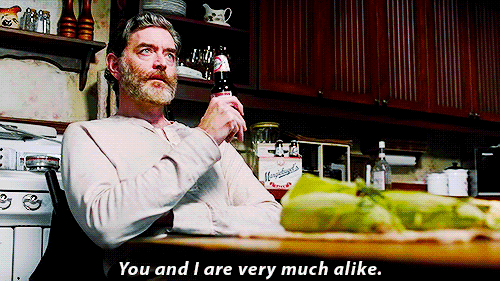
(x)
In fact, arguably 10x14 called for the audience to notice character mirrors before 14x04 did! Cain constantly reiterated that he was a Dean mirror TEXTUALLY. He told Dean that Sam was his Abel. He very clearly stated how Dean would live his life in reverse - Cain killed Abel first, then he unwillingly killed his wife Colette, before finally giving in and killing his demonic kin - the knights of hell.
He told Dean he would first kill Crowley - his own demonic kin in a sense, then he would kill Castiel - Deans... partner? Before finally killing Sam. How can I make this any clearer? Oh yeah. This:
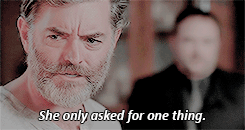

In fact just got take a look at the source post for those gifs to see all the other ways Cas is a mirror for Colette and watch me laugh at anyone still trying to deny this: http://casclaire.tumblr.com/post/119456988024/and-everyone-you-know-everyone-you-love-they
Those were the het pairings (among many others) but Dean and Cas have also been mirrored to practically every other queer pairing in the show save one (and that was played purely for jokes for W*ncest fans).
Now the importance of queer representation is something we frequently discuss in fandom. So before some asshat decides to pipe up and accuse me I’ll just add a nice little disclaimer so said asshat can shut the hell up:
Theorising that queer pairings in Supernatural may also be mirror pairings for Destiel does not diminish the pairing or the representation in its own right. To claim it does so is utter bullshit. The pairing is still awesome and should be celebrated because hey! It’s on the show isn’t it? It’s out in the open as a canon queer pairing! YAY for US! Speculating that it could also be a Destiel mirror pairing only ADDS to the awesomeness. It does NOT diminish it in any way...
Unless you hate Destiel of course in which case... well:
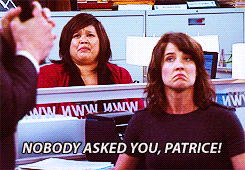
So now we’ve got that out of the way:
Several of our best queer pairings in SPN over the years can also reflect Destiel and their relationship.
Charlie and Gilda is a prime example:

Gilda appears in episode 8x11 as a fairy from another realm who has been taken prisoner and forced via magic to do horrible things against her nature by a bad guy. Charlie is able to free her from her “masters” spell.
Sound familiar?
It should do, because this is basically Castiel’s story in season 8. He is brainwashed by Naomi to do bad things against his nature which culminates in Dean managing to break through to him by declaring how much he “needs” him. Isn’t it all so marvelously gay?
How about this awesome gay couple:
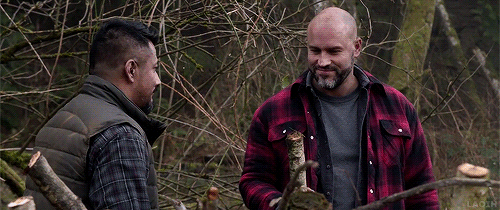
(x)
Honestly I could wax poetic about this episode for a thousand years, but I will just stress this: Anyone who tries to suggest that the mirror here is for Sam and Dean is clearly missing the fact that the entire point of this episode was about a BROTHER getting revenge for and mourning the loss of his BROTHER. So the Brother mirror is already well established at the start of the episode.
But Cesar? Cesar is all Cas. He’s the “foreigner” supporting his partners revenge quest regardless of his own desires. Hell, even their names are similar. Besides, their entire relationship was a lesson for the audience in how to recognise body language. All those shoulder squeezes and longing stares? Destiel was all over Jesse and Cesar. I have no doubt in that.
But if that didn’t swing it for you how about this lovely canon pairing?
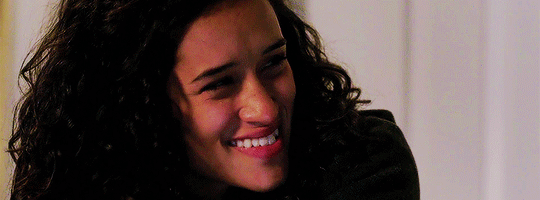
(x)
The fandom coined “DreamHunter” pairing between Claire Novak and Kaia Nieves was built completely on famous Destiel moments. Longing looks, pledges of protection, “I’ll go with you”, saving each other, trying to go back for each other, mourning the others death… Dreamhunter was also still completely subtextual until recently when Jody Mills stated “First love strikes quick” a simple sentence, and it was confirmed as canon in the show.
Here’s a handy post of how dreamhunter was built on a Destiel framework:
http://bluestar86.tumblr.com/post/179549508598/tinkdw-first-love-strikes-quick-to-lose-it
Other than these obvious pairings above, there are literally hundreds of character mirrors used throughout the show’s 300 episode run so far which are put in place by the writers and the crew specifically to indicate some deeper meaning to the overall lead character emotional arcs. This has been common and frequent in the show throughout its long history. The above examples are just the most obvious ones related to either Sam and Dean or Dean and Cas. Almost every episode of this show includes character mirrors in some way or another. Character mirrors specifically linking to Dean and Cas have been particularly frequent throughout Carver and Dabb era (practically every episode in season 8 had a tragic human x immortal creature love story for example).
So for ANYONE to argue that we are seeing mirrors where they don’t exist? Well, those people are straight up wrong. I don’t care who they are, or whether they have some status within fandom or if they are just some asshole on the internet, unless the denial of character mirrors is coming from the writers or the directors of the episodes, they are wrong.
Which leads me nicely to this:
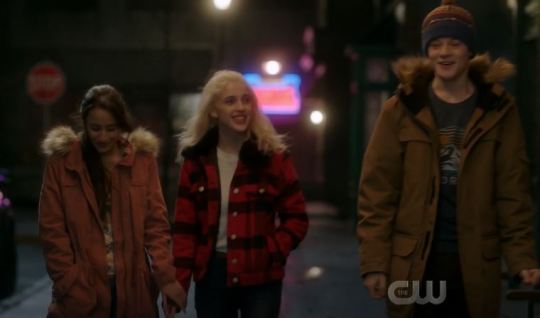
My reason for writing this long meta post was because of this. Simple enough right? We got three kids in 14x13. One is a tall nerdy boy who just seems to radiate with the same aura as Colin Morgan’s young Sam Winchester. One is a fiery young lady called Max, who wears a plaid jacket and has a shy crush on her friend - she also gets behind the seat of the Impala at one point as if that wasn’t obvious enough. The other girl Stacy we don’t know much about, other than that she is quiet, pretty, with dark hair and clearly the object of Max’s affections.
When I first watched this episode with @tinkdw and this scene came up we both didn’t even have to think about it. It was so clear to us. Nice one SPN, we see what you did there. The framing, the characters personalities, the coded clothing... there wasn’t a doubt between us that this was framed intentionally, and in a scene literally moments before Cas comes home to his family.
It was supposed to be simple, no big deal. Yet another Destiel mirror among the mountain of Destiel mirrors the show has already given us. Its not even anywhere near as impactful as one of the character mirror pairings previously mentioned in this post. Yet it was enough to cause such a huge wank storm on Twitter and have BNF accounts start a parade of abuse and blame towards meta writers for even DARING to consider that Destiel mirrors may exist AT ALL in this show, let alone with author intent!
Colour me effing surprised.
If ANYONE tries to tell ANY Destiel shipper that they don’t have a right to see character mirrors in the show, to believe that there is author intent, to SHAME them for seeing those mirrors in queer pairings specifically. You go right ahead and block those people. Because their opinions are their own no matter how much they may scream like they have some kind of authority. They don’t.
No one has any authority over the way you interpret the media you enjoy. Even me.
Don’t forget that.
So my point on this post was basically to say this.
You go right ahead and keep looking for character mirrors in SPN, because they have been intentionally included in the show since its humble beginnings. Destiel mirrors are a huge part of that. You are NOT wrong for seeing them.
Max and Stacy in 14x13 were just the latest in a long line of Destiel specific character mirrors in a show renowned for using character mirrors to the point that it has textually given its audience A. Lesson. In. How. To. Spot. Character. Mirrors.
I am not making this shit up.
At the end of the day, by believing the mirrors are intentional, and what makes this post controversial, is that it means I am telling you that TPTB are intentionally providing us with romantic Destiel subtext.
Well, that is exactly what I am saying. Because they are. There is no doubt about this. You don’t fill your show to the brim with romantic tropes, romantic character mirrors and an underlying romantic narrative C plot for at least 4 seasons without having some intentional desire to potentially make this thing an actual thing.
You just DON’T.
The writers know what the hell they are doing. They want to keep Destiel an option for endgame, so they keep it going throughout the show. Whether or not they eventually make it textual to a point that a general audience can’t deny its existence is another story, because that’s the kind of thing that need a green light from the CW suits.
But the writers, the creators of the show, everyone involved to an extent, they all know what they are doing. Anyone who at this stage would deny author intent regarding Destiel loses all my respect because frankly its insulting to the creators themselves. No one is so idiotic that they would make something look unintentionally romantic for 10 years.
The mirrors are real. Destiel is real. The creators of SPN continue to include it so they can keep it an option for endgame because (and this is the part I don’t know for sure but can at least guess because I don’t consider the entire writing team to be asshole queerbaiters) they want to make it canon as much as we want it to be canon.
Whether they actually CAN or not is the issue at this point. The debate on whether or not we “are reading into things” has been null and void since season 12. It was practically null and void since season 8 TBH.
So keep looking out for the Destiel mirrors (and the Sam and Dean mirrors and any other character mirrors you may pick up on) and you go right ahead and post and speculate and tweet and blog and do whatever the hell you want to do to voice your opinion on the topic because NO ONE has the right to police what you see in the show - especially when it has already been proven to be clearly intentional on the part of the creative team.
Finally I will leave you with this humble message from our “overlord” in case my post hasn’t already swayed you away from negative thinking and believing the deniers:
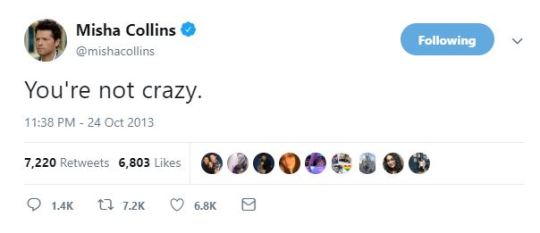
Thanks for reading. :)
#supernatural#destiel#spn meta#deancas#destiel meta#castiel#dean winchester#mirrors and parallels#romantic mirrors#destiel mirrors#romantic tropes#the greatest love story ever told#spn 300#season 14#carver era#dabb era#14x13#narrative mirrors#destiel dreaming#spn speculation#author intent#my meta#inspired by fandom drama#powered by spite#like most things I do nowadays#long posts for ts
483 notes
·
View notes
Text
Disney+ What To Watch: My Top 10 Favourite Modern-Day Disney Classics

#3. Lilo & Stitch
Of all the movies I have talked about so far, this movie is the one that has shocked me the most with how much I enjoy it and how high it is on this list.
At first, the only real good takeaway from this movie is Stitch as a character, with both how cute he is and the surprising take on the traditional fish out of water story.
However, as I have gotten older and been able to decipher the hidden and deeper meanings of these movies, I have to say the true meaning of family that runs throughout this movie is very heartening and very true to life particularly for a Disney animated movie.
Especially when you consider that this movie came out during what could be known as Disney’s second “dark times” after the 80s where the Renaissance had finished and Disney was trying to go in a different direction with very mixed results, this is definitely the shining beacon in the murky waters of Treasure Planet, Brother Bear, Home on the Range and especially Chicken Little.
Not only is the animation styling unique to the movie and, a lot like Moana and Princess and the Frog, animates Hawaiian natives in the styling of how they actually look so that they can’t look like any template design for any ethnicity. But the way in which this movie incorporates land, sea and outer space and makes them all feel like land, sea and outer space.
Lilo & Stitch is not shy of delving into the real-life struggles of depicting how a family in these sisters’ position live and get by. Nani struggling to find work because she spent her formative years as the guardian of her young sister, Lilo having a very damaged upbringing because she lost her parents young and, because she is an outsider who sees the world differently to everyone else, she doesn’t fit in with the other girls her age. She seeks solace in the fact there is a fish who controls the water and must be appeased but also recognises that she is troubled.
It’s then clearly fitting that a recently created alien crashlands in their neighbourhood and crosses paths with them. Stitch is like Olaf in the sense that because he has only just been created he has no real morals or ethics and, because he is an experiment designed for destructive purposes, has very high anger management issues.
However, what I love is as much as the movie focuses on Lilo and Nani’s relationship and particularly Nani’s struggle to keep them together, it also explores Stitch wanting to feel like part of a family and the parallels to the famous story of the Ugly Duckling.
Honestly one of my favourite parts of this movie is the “Hawaiian Roller Coaster Ride” montage when David is trying to cheer up Nani and Lilo and all Stitch wants to do is be involved and be a part of the fun. Honestly one of the sadder moments are when they’re making sandcastles and Stitch sees the three of them enjoying the fun and tries to emulate it himself...I can relate rather a lot to looking in from the outside.
I mentioned that a recurring theme with this list would be outsiders and both Stitch and Lilo are definitely outsiders, but this movie shows how that’s not exactly a bad thing as them being outsiders is what brought them together and by the end of the movie it is essentially a family of outsiders but more functional a family than most traditional nuclear ones.
Stitch is adorable, not only does he have that newborn innocence but because he doesn’t really talk until towards the end of the movie and mostly communicates in noises...very relatable by the way...he is even more likeable because of the fact we effectively see him mature throughout the movie so that by the end, when he stands up to the Grand Councilwoman, not only does he earn that moment but again it is just so cute that he can talk like a human and, I know others have tried but, no one can do his voice like Chris Sanders.
I don’t know why but, watching the movie on Disney+ for the first time since getting my dog, makes me compare my dog to Stitch and how my dog would act if he was more anthropomorphic or of alien origin like Stitch,
Lilo and Nani were very well established in terms of their sisterly bond, it is clear that Nani works her butt off in order to not only provide for the two of them but also to ensure they stay together. I mean the fact that Nani reduces herself to working at that fake luau place just to makes ends meat speaks volumes to how much she cares about her sister.
But I also enjoyed whenever they argued or quarrelled because, at the end of the day, they’re still sisters and sisters fight. Siblings fight, regardless of if one is the primary care giver or not and the fact you see the explosive rows, the fallout and the two of them making up afterwards just shows a fully-realised family unit.
It’s also a strong statement to the sisterly bond that Nani doesn’t give in to her “womanly urges” and gets with David despite the many, many times he offers. Yes, it maybe would make life easier to have another source of income and immediate support network in the family, as established at the end when they actually get together, but throughout the movie the amount of times he asks and she rejects is all for legitimate reasons. They’re under scrutiny from social services so adding a new relationship at this point would not be good.
As for our alien antagonists, this was the first time that Disney Proper animation had featured aliens in their movies, because Toy Story was 1) Pixar and 2) Featured toys not actual aliens.
But I really enjoyed these aliens, while they are all clearly of different species, not knowing the species and simply focusing on who they are as characters was really fun. the Grand Chairwoman looked like an authoritarian figure, both Jumbaa and Gantu looked menacing Jumbaa looked goofier than Gantu so of course Gantu was the bigger threat than Jumbaa.
Pleakley is a revalation for Disney Animation and yet it’s played up more for laughs then anything else. It’s not just that he enjoys dressing up like another somewhat famous alien from American Dad! but the fact he specifically enjoys dressing like a woman...Disney had it’s very first transsexual character on their hands and yet he’s never been promoted as strong LGBTQ+ representation for Disney.
I absolutely loved the inclusion of an Elvis Presley soundtrack to this movie. The fact you’re combining a Hawaiian setting and a sci-fi space theme with the music styling of Elvis is very clever and it works so well. Also Gareth Gates’ version of “Suspicious Minds” is still a favourite of mine.
One thing that always sticks in my mind was the lead up to this movie particularly in the ad campaign of having four teasers beginning with iconic scenes from the four most iconic Disney movies of the past decade being hijacked by the at the time untested new character followed by different snippets of his own movie before releasing a full trailer.
It is one of the best examples I know of a successful PR campaign as it gained a lot of interest for the movie.
I also really really enjoy the longevity of this franchise. As I said, this movie resides in that Post-Renaissance era which was very hit and miss for fans, but the fact that we not only got three direct-to-home sequels as well as a progressive spin-off series akin to the Aladdin and Hercules animated shows. But I have seen that there are other recent animated shows about the titular characters and Lilo & Stitch is even getting a direct-to-digital live-action/CG-hybrid remake...who would’ve thought this movie would have such strong legs.
If for no other reason, I can whole-heartedly say that Lilo & Stitch is a reason I am thankful for Disney+ as it has re-energised my fondness for this movie, I mean I always loved Stitch and always will, but over the years I have managed to revitalise my love for the movie on multiple levels.
So what do you guys think? Post your comments and check out more Disney+ What to Watch Top 10s as well as more Top 10 Lists and other posts.
#disney#disney+#disney plus#disney+ what to watch top 10s#disney+ what to watch#my top 10 favourite modern day disney animated movies#my top 10 favourite modern day disney classics
4 notes
·
View notes
Text
How to Create the Ultimate Lead Capture Page: 11 Tips for 2020
I created my first lead capture page four years ago when I started my business. Let me confess to you now: I didn’t have a clue what I was doing. I wanted to advertise my services, grow my brand, build an audience, and land clients. And I thought I’d created a campaign that would do all that and more.
But I’ve learned a lot since my first campaign—and what I know for sure is that I did almost everything wrong.
So whether you’re just starting your marketing journey or trying to improve your conversion rates—aren’t we all?—here’s what I wish I knew when I created my first lead capture page. Follow these 11 tips to bring in more prospects and overachieve your campaign goals.
What’s a Lead Capture Page?
A lead capture page is a type of landing page that offers your audience something in return for their email address or other information. This means that any page with a form on it can be considered a type of lead capture page—including ebook download pages, demo request pages, or newsletter sign-up pages.
Unlike other pages on your website, a lead capture page only has one goal: exchange a lead magnet (or reward) for your visitor’s info. Get this exchange right, and you’ll be able to turn more of your fans and observers into full-fledged leads and customers.
11 Tips to Create Better Lead Capture Pages in 2020
Know Your Goal
Create a Compelling Reward
Pick the Right Form Fields
Consider Your Traffic Sources
Craft a Message-Match Headline
Use Social Proof
Keep Your Copy Short and Clear
Write an Actionable Call to Action
Apply Conversion-Centered Design Principles
Optimize Your Form
Create an Incredible Post-Conversion Experience
Tip #1 – Know Your Goal
Your lead capture page has one job to do (and it needs to do it well). So before you plan a fantastic design or write a catchy headline, decide what your page needs to accomplish. What’s your one goal?
Start creating your goal by thinking about which audience you’re building the lead capture page for. There are three main types of audiences when it comes to lead capture pages:
Leads – Leads are the new people to your audience. They don’t know you well, but they’re intrigued by what they’ve seen and would like to learn more. You’re basically strangers who have just been introduced, and it’s your job to start the conversation and become best friends.
Prospects – A prospect is somebody who’s already some interest in your product, offering, or service, but who hasn’t yet converted into a customer. They’re likely in your CRM, nurtured with emails, blog posts, and social media posts. If this were a relationship, you two have been dating, but aren’t official… yet.
Current Customers – Current customers need attention and relationship building as well. They may be in love with your product or they could be cold and considering churning. An offer created just for them could be the thing they need to pique their interest. Keeping the relationship metaphor going—you’re married, but it’s still important to go on dates to keep the romance alive.
Once you know who your lead capture page is for, you’ll want to decide what it’s going to do. Create clear and measurable targets based on previous campaigns or industry averages. Do you want to generate 50 new leads a month? Or have a 12% conversion rate? Decide what metrics you’re aiming for before you begin, and you’ll better be able to track how the lead capture page is performing.
For example, this lead capture page from Arrive does a great job of choosing one specific audience and making it very clear who this guide is for—New Canadian residents looking for help on their taxes.
Target your lead capture page with a specific audience in mind.
Tip #2 – Create a Compelling Reward
The lead capture page is all about an exchange—they give you information, and you give them content. While that sounds like a no-brainer, most people don’t trust companies on the internet. You have to make the reward or offering so enticing that visitors are willing to trust you with their personal info.
There are lots of types of rewards and each has a special appeal to a particular segment of your audience.
Ecourses – An ecourse helps you showcase your knowledge and expertise while being helpful to your audience. This type of content is so versatile any of your audience segments could find it an intriguing offer.
Reports/Whitepapers – A whitepaper is a great B2B reward for prospects and leads, with over 82% of buyers saying they rely heavily on whitepapers to make purchasing decisions.
Ebooks – An ebook or a comprehensive guide can help your leads and prospects learn more and take the step to become customers.
Webinars – 60% of webinars can take your audience from lead to prospect. Webinars provide great value and they’re another tool that helps you teach your audience while establishing authority.
Product Demos – Your product demo can be a great reward for the bottom of the funnel to help you attract interested prospects.
Free Trials – A free trial lets your prospects and leads try before they buy. Usually, they’re between seven and 30 days, depending on the product or service.
Challenges – A free challenge is another way to give short term access to your services or product. Nathalie Lussier used a free challenge to grow her list to over 55,833 subscribers in just four years.
Newsletters – Newsletters nurture your audience. Ideally, they’re sent out with some regularity and focus on a theme. Depending on the content of your newsletter, this reward would appeal to all segments of your audience. Newsletters allow your subscribers to become familiar with your brand, voice, and subject matter expertise.
Checklists – A checklist can be a simple offer to help beginners. You can quickly design a PDF page using Canva and put it out as a helpful resource for your audience.
Templates – Later created social media templates to help social media managers and small brands with their social media reports. Visitors find templates like this valuable because they help you save time.
Check out the full customer story to see how Later used landing pages like this one to capture over 100,000 leads.
Tip #3 – Pick the Right Form Fields
The form field is the first place of friction your audience will feel. This is where they’ll ask themselves, “is it worth it?” or “do I really want this?” When you ask a lot of questions (and get a lot of answers), you’ll have some well-segmented data and qualified leads to work with. But how many prospects or leads did you lose by asking too many questions?
Remember, your lead capture page has one goal, so figure out the least amount of info you need from visitors to make that goal a reality.
A few things to consider when choosing how many form fields you put on the page:
If your content only targets marketing managers from early-stage startups, do you really need to know the “Title” of the person filling out the form?
If your goal is to increase your list size 10% each month, do you have to know the person’s phone number or company name?
Research by Hubspot shows that more form fields resulted in fewer conversions.
If all goes well, this won’t be your last time to learn more information about your audience. Each email and offer can help you learn more about who they are and what they need.
The Bruery, for example, has been brewing bourbon barrel-aged imperial stout for ten years and is growing a list in a straightforward way: they only ask for an email address. No need for names, phone numbers, or addresses—they know they can gather that information at checkout.
Right now, they want to capture their audience while they have a little bit of their attention. The team can nurture their prospects later on, while the next batch ages in the barrels.
One-field lead capture pages tend to see higher conversion rates.
Tip #4 – Consider Your Traffic Sources
There are multiple ways someone can discover your offer. When you create a lead capture page, think through all the best ways to attract your target audience.
Common traffic sources include…
SEO – This is a standard Google search. The people that find your page by a search engine are looking for something in particular, but they may not be aware of all of the solutions. Lead capture pages don’t typically drive a ton of organic traffic, but you may want to do some keyword research to see if there are any opportunities. Consider using a related piece of content (like a long-form blog post on the same topic) to try to rank higher in the search engine results, and then promote your lead capture page by linking from that post.
PPC (Pay Per Click) – These ads are the first results on Google or the ads you see when visiting a website. When you click on the ad, the business pays a certain amount per click. When using PPC traffic sources, your audience probably doesn’t know much about you or your offer. The rewards that will be the most helpful to an audience is usually educational, like an ebook or webinar.
Social Ads – Ads on social media will allow you to use filters and the social media platform’s demographic data to target exactly the right type of audience. But even with all of this targeting, your reward must be compelling for prospects and leads who click through.
Email – Your email list is a powerful traffic source with incredibly high conversion rates. Optinmonster found that every $1 you spend on email marketing earns around $44 in return. You might be able to leverage email as a traffic source if you’re hoping to capture more information from leads already in your CRM.
Organic Social Media – Apart from paid ads, you can (and totally should) post your lead capture page to your own social media pages. This audience follows you already and is interested in what you create, share, write, or build. Traffic from this source tends to be warmer and more likely to convert.
Tip #5 – Craft a Message-Match Headline
You’ve done the audience research and quality reward work, and now it’s time to put the lead capture page together. Your headline is the eye-catching phrase that, in a few words, will tell the audience exactly what it is they’ll be getting when they sign up.
Keep your messaging consistent across the customer journey from ads and emails to the lead capture page itself. A consistent message keeps things simple and clear for your audience. For example, this is how Taboola advertises a lead capture page for their ebook on how to launch a content discovery campaign.
And here’s the lead capture page itself. Notice how the messaging is simple, clear, and consistent.
By staying consistent, you’re signaling to visitors that yep—they’re in the right place. “This is the ebook you’re looking for.” It’s a simple but important principle that will almost always get you a higher conversion rate on your pages.
Tip #6 – Use Social Proof
Every lead capture page should use some form of social proof. Why? Because a Bright Local survey found that 91% of consumers are more likely to buy when they read positive reviews. Sharing testimonies, partner logos, or even the numbers of people who have previously signed up will show your audience that what you have to offer is valuable.
This example from Do You Yoga does a fantastic job integrating their social proof into the design of the page. Right below the “Join Free” CTA they let you know that 18,902 other people have already decided to sign up. It’s subtle—but super effective. (Because you know you’re in good company if 18,902 other people have already signed up!)
Tip #7 – Keep Your Copy Short and Clear
You want every word and phrase to have a purpose. Your copy has a short amount of time and space to convince the reader to sign up. Make sure your copy is benefits-driven, meaning you’re telling the reader exactly how signing up will benefit their life. Show precisely what they can expect after they hit the call to action button.
Pared’s headline and subhead nail it by describing the who, what, and why of their app in just a few short sentences.
Tip #8 – Write an Actionable Call to Action
The call to action is the button on the page that invites the reader to take the next step in the process. This little button’s copy may not seem important, but the right tweaks to CTA buttons can increase your CTR by up to 90%. Your CTA needs to invoke action. ‘Learn More’ might be fine, but ‘Get Your Ebook’ tells the reader exactly what clicking that button will get them. In our template gallery, we have tons of actionable CTAs for any type of campaign or lead capture type.
If your page is for a SaaS product, ‘Choose Plan’ or ‘Sign Up’ could be the best option for your CTA.
Webinars would require a different action than an ebook or checklist. Each offer should have a unique CTA that guides the reader to action.
Tip #9 – Apply Conversion-Centered Design Principles
Check out all the conversion-centered design principles to optimize your lead capture page.
Conversion-centered design means that every aspect of your funnel from the ad to the form on your lead capture page is thoughtfully placed. You want to guide the prospect toward conversion and retention.
Unbounce has a seven-principal framework that will help keep your campaigns focused and successful. The conversion-centered design framework goes deep on each principal, so if you need a more comprehensive lesson, I encourage you to check it out.
The TL;DR Conversion-Centered Design Key Takeaways
Consistent design – Make sure you’re giving your prospects all the information they need to make a decision and convert. Your messaging, design, and copy needs to flow seamlessly from pre-click (your ad, email, or social post) to post-click (the lead capture page).
Keep the design simple – Stay focused on your one goal, and you’ll see a higher conversion rate. We experienced this first-hand on one of our landing pages—by eliminating all other distractions, we increased visits to the next page in the funnel by 172.1%.
Credibility – To be seen as a credible business, you need to show as many sources of credibility as you can. Certificates, testimonials, reviews, and privacy policies are all effective ways to convey your trustworthiness.
Tip #10 – Optimize Your Form
To optimize your lead capture page, think through each tiny detail, and ask if there is an easier way to get the same result.
Any tweak you can make that reduces the amount of work, thinking, or reaching for a wallet your prospect has to do will help increase your conversion rate. In fact, Wp Forms found that 67% of site visitors will abandon a form if they have any complications. Enabling auto-fill fields helps reduce the number of things your prospect has to do before clicking the CTA. So, do the heavy lifting for them and use auto-fill fields for name, email, and credit card number.
Multi-step forms may sound like an oxymoron to optimization, but experiments have shown that using multiple forms can increase conversions by 300%.
Multi-form best practices say:
Only ask one or two questions on a page.
Provide a visual for where the lead is in process, like a page/question count.
Don’t ask more than 10 questions in total.
Provide immediate value after they submit the form.
Tip #11 – Create an Incredible Post-Conversion Experience
Your post-conversion experience is every interaction your prospect has with your brand/company after they click the call to action. When you create an incredible experience that meets the needs of your customers, they tend to stick around longer and purchase more.
Remember our relationship metaphor? The post-conversion experience would be like going on a fun date, and then never texting or reaching out again. (Rude.) You both had a great date, and now’s the time to build a real long-term relationship.
How to Create an Incredible Post-Conversion Experience?
Set up an automated email campaign – If your lead magnet teaches new gardeners how to grow giant tomatoes, then you know that your prospect is looking to learn more about gardening. You could create an automated campaign that sends them a tip of the week. This tactic helps them and builds their trust in you at the same time.
Explain the next steps – Let your prospects and customers know what to expect next. Will they get their download in their inbox or will the reward open right after they click? Are they being subscribed to a newsletter, or will you only email them once with the reward?
Build their trust – Trust and relationships have become the cornerstone of the post-conversion experience. Your prospects want to trust you before becoming customers, so to build their trust, be reliable and honest with their information. If you say you only need an email address to send the reward, then don’t add them to every newsletter automatically.
Test and iterate – The best way to ensure your lead capture page is serving your audience is to test and improve. Think about your one goal and the metrics you wanted to meet and ask yourself, “is the page performing the way I wanted?” Where are there improvements to be made? Consider tiny details such as button color, or swapping all the “I”’s for “You.” You can even use Smart Traffic to test multiple variants at the same time and get results faster.
How to Create a Lead Capture Page Quickly
Building lead capture pages in your website can be a tedious process that puts a limit on your creativity and choices. That’s why Unbounce has a ton of high-converting templates to help you build and customize fast.
We know these tips and best practices lead to success, so we’ve baked them right into each template design. Choose the templates that serve your needs best, then filter by tool, campaign, type, or special features.
from Marketing https://unbounce.com/landing-pages/how-to-create-the-ultimate-lead-capture-page/ via http://www.rssmix.com/
1 note
·
View note
Text
Oh, I have so many people to respond to with all this talk regarding Michelle, being an MJ ‘purist’ (lulz) and all that other garbage when it comes to the MCU but for now here is a something to think about.
If Michelle is indeed the MCU Mary Jane Watson, and she will thus fill the role of being Peter’s endgame love interest/life partner (whether or not that results in marriage way down the line or not) then her personality being unrecognizable to comic book Mary Jane’s, whether you say it’s a ‘composite’, an OC, or whatever, is a humungous problem.
And I don’t mean on the principle of it’s an adaptation by it’s nature it simply should strive to respect the source material.
No, I mean on an innate storytelling function level her personality being nothing like comic book Mary Jane’s breaks the role I spoke of above.
Mary Jane was never ever simply the inserted love interest for Spider-Man, the character there because the hero needs a girlfriend. She wasn’t a template inserted into Peter’s life nor was she the character who happened to stick around long enough or be portrayed in the right way at the right time that she became iconically associated with the male hero.*
I’m not even talking about how she wasn’t originally intended as Peter’s girlfriend but evolved into that anyway.
What I mean is…Mary Jane’s personality is actively the best possible match for Peter Parker’s.
I’ve spoken about this countless times but I’ll try to make this short. Peter and Mary Jane realistically and creatively perfectly complement one another by having a good balance of similarities and differences.
MJ is outgoing, sociable and can be goofy at times. Peter in his civilian identity is more reserved, sociable but less so, and much more serious. She lightens him up and he can make her take things more seriously when needs be.
They’ve both lived double lives, Peter through his costumed persona, MJ though her party girl act.
They’ve both seen their family’s shattered and had to step up to pick up the pieces. Peter’s parents died and so did Uncle Ben. Mary Jane’s parents divorced, her sister’s marriage fell apart leaving her to care for 2 children and her mother died when she was just a teenager. Peter had to provide for himself and Aunt May by working at the Bugle. MJ had to provide for her mother and sister by working fast food jobs and stuff like that.
Through these similarities and differences they fulfil one another’s fundamental emotional needs.
Peter needs someone to help ground him, to enable him to ‘be normal with’, but who is also strong enough to carry his secret and defend herself. MJ meanwhile wants someone who understands pain, guilt, living a double life and who knows about power and responsibility (because her father, a figure of power, used that power irresponsibly by abusing her).
What I am getting at is…if you want Spider-Man to be Spider-Man but also want him to have an endgame love interest then that love interest needs a personality and a history broadly similar to 616 MJ’s. Maybe not beat for beat the same but broadly similar yes.
Put it to you like this, were Michelle an adult with the same personality and she met comic book Peter Parker of the same age they would never wind up together. She isn’t his type and her personality traits and background (whatever the fuck that is) would not jive with his long term to form the foundation of a strong ongoing relationship.
Now of course the counterargument I can already hear is that MCU Peter is different to 616 Peter, therefore if he was to have an endgame girlfriend she doesn’t have to/shouldn’t have the same personality as 616 Mary Jane.
The problem with that line of thought being that the personality MCU Peter has ALSO doesn’t jive with Michelle’s.
Yes to an extent they are different but beyond an entirely presumed notion of them both being ‘smart’ (we don’t really see this in Michelle beyond her reading a lot in Homecoming) there isn’t a healthy balance of similarities and differences.
We’re simply left wondering why either of them like one another beyond looks.
What exactly is it about Michelle and Peter’s personalities and life styles that help balance one another out.
I mean real talk is Michelle exactly down to Earth? She’s a macabre misanthrope who revels in that and revels in that. She’s like a step or two removed from a goth, possibly just so she can seen attractive to mass audiences.
From a practically POV Peter’s job as Spider-Man would be steeped in a fair amount of violence and death, or at least the very real possibility of it were it not for his intervention.** The MCU are too pathetic to acknowledge that though so instead we get ‘jokes’ involving his teachers, but if Peter was really a crime fighter in the MCU he’d encounter violence and death a lot. This is another reason why MJ’s ability to empathize and her own zest for life is important in terms of their relationship in the comics.
But in the MCU realistically if Peter just saw Sin Eater blast away innocent civilians and then he comes home to Michelle’s macabre art and shit like that best case scenario it will bum him out more. Worst case scenario he’s going to call her out as extremely pretentious as she is over here revelling in the fact that loads of people got executed at this historical landmark whilst he just saw some old guy bleed out from a gun shot wound or got beaten half to death averting Doc Ock’s scheme to blow up New York with a nuke.
I’m not even saying people with those interests are bad people or shouldn’t take an interest in that stuff. I’m just saying the person Peter is, even in the MCU, wouldn’t believable have a long term relationship with that type of person. I mean it’s especially bullshit in Far From Home. He’s just seen Tony die after he himself literally experienced death as did the whole universe but he’s randomly got the hots for this girl who’s all about being macabre? Is that really the healthiest thing when he’s grieving?
And for her part based upon what we know of her besides his looks or the mystery surrounding him or the innate danger and glamour of him being a superhero (so you know nothing about who he is as an actual person) why would Michelle like Peter? Why is this very macabre person interested in someone who seems very upbeat, who she knows to be all about preserving life, cracking the odd joke, etc?
Opposites attract sure, but healthy relationships have a balance of differences to balance one another out and similarities through which people connect.
In summary:
a) Mary Jane’s particular personality and personality traits are important in so far as her role as Spider-Man’s romantic partner as they actually make her a good match for him
b) MCU Peter and MCU MJ’s personalities as established do not make them a good match, rendering their romance you know...shit.
But then again I’m just one of them goddam filthy purists aren’t I.
*For example….Dick and Babs. I ship Barbra Gordon and Dick Grayson I really do, but real talk the reason she and Dick are regarded as an iconic couple is because of Batman the Animated Series and comic book people incorporating that and enforcing it into the comic canon. From an emotional and more organic POV Dick and Starfire make more sense.
Or for another example Rogue and Gambit. Rogue was around for years before Gambit showed up and had had prior romantic flings but because of the 1992 cartoon Rogue and Gambit are forever tied together romantically.
**Death always had a presence in Peter’s story. Whether you identify it as his being an orphan, Ben’s death, May’s advanced age and poor health or the numerous deaths that occurred in the early adventures. I’m not even talking about Gwen Stacy either, Bennett Brant, Mendel Stromm, George Stacy, Frederick Foswell, the Finisher (who Spidey essentially killed himself) and that’s not even counting people who died in flashback stories to that era.
#Spider-Man#mjwatsonedit#mary jane watson#Mary Jane Watson Parker#MJ Watson#Peter Parker#mcu#Michelle Jones#marvel cinematic universe
42 notes
·
View notes
Text
Marvel Cinematic Universe: Guardians of the Galaxy (2014)

Does it pass the Bechdel Test?
No.
How many female characters (with names and lines) are there?
Six (31.57% of cast).
How many male characters (with names and lines) are there?
Thirteen.
Positive Content Rating:
Three.
General Film Quality:
Entertaining, but overrated.
MORE INFO (and potential spoilers) UNDER THE CUT:
Passing the Bechdel:
Though Nebula and Gamora trade a couple of lines on a few occasions, they invariably speak about either Thanos, or Ronan.
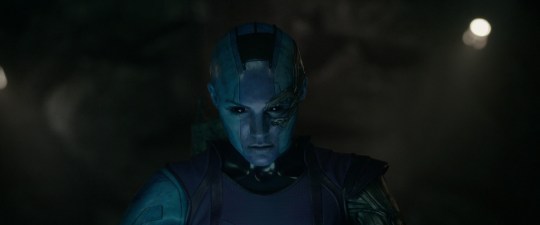
Female characters:
Meredith Quill.
Bereet.
Nebula.
Gamora.
Carina.
Nova Prime.
Male characters:
Mr Quill.
Peter Quill.
Yondu Udonta.
Ronan.
Korath.
Rocket.
Groot.
The Broker.
Drax.
Thanos.
The Collector.
Denarian Saal.
Denarian Dey.
OTHER NOTES:
Seatbelts on spaceships should really be mandatory.
Aahahahaha Peter has a woman on his ship whose name he can’t remember and whom he forgot was even there! Oh, it’s so funny and charming! What a classic misogynistic cliche intro! Garbage.

Rocket chastises Groot to ‘learn genders’, and I don’t think the irony of a raccoon (a species with almost no visually-evident sexual dimorphism) saying that to a tree-person (whose species - if sexually dimorphic at all - certainly has no reason to adhere to the humanoid/mammalian model) is deliberate. The other alien higher-life-forms they encounter in the film are pretty uniformly human in appearance (not much effort going on in the ‘alien’ department besides just painting people in bright colours), but lack of imagination from the creative team doesn’t mean that the binary gender system we’re accustomed to on Earth has any broad bearing on the galaxy at large.
Aaahh, and now Peter is explaining his scars to Drax, with lovely stories of women he cheated on in the past because he’s ~such a stud~.
Thanos tells Ronan off for his dull political raging and whiny behaviour, but he’s sitting on a shiny floating throne himself, so I’m not sure he’s earned the right to criticise what other people have got going on.
Rocket suggests that Gamora trade sexual favours to get things from other prisoners, because we’re being Like That with this movie.
The Collector keeps female slave ‘assistants’, whom he evidently treats so nicely that Carina commits suicide by infinity stone at the first opportunity in order to escape him. We’re just doing so well for the ladies in this film.
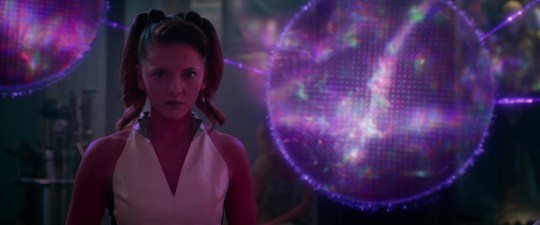
As a great comedic beat, Drax calls Gamora a “green whore”. It’s both a shitty line, and nonsensical, since Drax isn’t supposed to comprehend metaphors and he has no reason to believe Gamora is a literal ‘whore’ (nor is he likely to use such a colloquial term, considering the calibre of his standard vocabulary). Basically, it’s a rubbish line from every angle, and all in service of a misogynistic joke.
This film is a terrible waste of Djimon Hounsou.
Ronan is very theatrically over-the-top in his pronouncements, but Lee Pace does his damnedest to make it work on delivery.
Why does Ronan’s flashy purple infinity stone weapon not kill people when he shoots them with its energy blast? Obviously it would be terribly inconvenient to the story if he just casually killed all the good guys, but honestly. It doesn’t make much sense. They coulda at least pretended there was a reason.
The part of me that is susceptible to acts of heroism is affected by the guardians all joining hands to share the stone’s power. Not enough to feel that the film or the character relationships actually connected on an emotional level, but enough that this ending doesn’t feel totally unearned.

Drax patting Rocket’s head while he’s crying over Groot is a lovely touch. THAT is the strongest character interaction of the film.
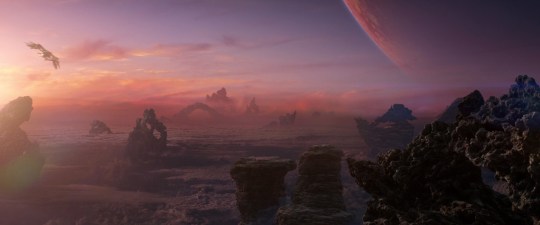
So. I’ll be honest: I don’t like this movie. I don’t think it works. I think it’s essentially just a string of gimmicks, loosely attached, entertaining enough on the surface but with no meaningful depth to hold in the mind or keep the audience engaged once the credits kick in (it’s also much heavier on the sexist tropes than any other MCU film previous). I don’t hate it, but it doesn’t give me anything that I value in a viewing experience, it just happens and then ends and that’s it. And the reason it doesn’t work is, frankly, the writing is lazy as shit. It makes a sub-par effort at establishing character and thus relies heavily on cliches, it rarely bothers to incorporate relevant plot and motivations and such into the story at early points in order to generate narrative pay-off, and the world-building is hazy at best and, like the characterisation, trades predominantly on expectation of stereotypes rather than actually creating anything original.

Let’s start in the obvious place: with our lead character. I’m tempted to just say ‘Peter Quill is garbage’ and then move on, because it’s true and also, he’s just not complex or interesting at all, which is ridiculous because he’s got that whole ‘alien abduction’ origin story and there should be like, literally any layers at all to his story instead of him just being an obnoxious Lothario who makes pop culture references like that counts as having a personality. But, here we are. I’m not familiar with the comics so I don’t know if this is a common complaint from fans who can’t believe their boy got all his nuances deleted in favour of such an inane cliche, but if this is exactly what Quill is like in the comics too? That’s no excuse. Part of the magic of adaptation is the opportunity to improve upon things the source material did wrongly or badly. The Quill we’ve got here in this movie is such a bland template he’s almost functionally useless; he barely impacts the story at all, especially in any way that is relevant to his personality or skills and necessitates his presence (the dance-off distraction is the only good Quill moment, and it’s also one of the few inspired choices in the whole film). At the end of the day, Quill exists so that the story has a Main Guy, being a straight white American male (and making sure we all, excessively, know about it), because God forbid we be expected to identify with anyone else. I have heard people sing the praises of the film for ‘subverting cliche’ by not having Quill and Gamora actively hook up by the end, as if that somehow makes it better that every single other aspect of that tedious forced romance plot is still squarely in place and set to play out in future films (pro tip: if the main guy still ‘gets the girl’, only it doesn’t happen in the first film, that’s not subversive. That’s still playing the trope dead-straight). Quill not immediately being shown to be rewarded with sex is not some incredible feat of original storytelling, and it certainly doesn’t absolve him of being a dime-a-dozen pig of a character. If that’s the most ‘unexpected’ character element you can cite, you’re in dire straits.

Now, I’m not gonna talk about every character individually, because in most cases there’s not much to talk about; Drax is the big warrior guy with the Fridged Family backstory we’ve seen so many times before it elicits zero (0) emotions now; Groot - though an interesting idea on paper - is basically just a Deus Ex Machina of whatever ability is most useful at any given moment, too ill-defined to have boundaries to his powers and conveniently not using his full potential whenever it would allow the characters to win too easily; and Rocket, well, Rocket is actually the only one of the leads who manages any meaningful nuance, which is unfortunate because most of the time he’s just used for sarcastic comic relief. The other character I am going to talk about is Gamora, and it’s because she’s a prime example of how this movie fails to establish things so that they feel like they actually matter or the character’s motivations are understandable, etc. We are introduced to Gamora when she overrides Ronan’s order for Nebula to retrieve the orb from Xandar; as it turns out, Gamora’s introductory moment (literally the first time we see her or hear her speak) is also her act of rebellion when she puts into action her plan to escape Thanos’ clutches and go her own way. The problem, obviously, is this is her introduction. We’ve never seen this character before, we’ve only just met Ronan and Nebula as well, Thanos is barely more than a concept, as is the planet Xandar and the politics around it. Nothing has been established yet about the life that Gamora occupies, so her ploy to escape it? Meaningless. We don’t even find out that Gamora was not planning to retrieve the orb for Ronan until she tells us so after she’s been arrested, and we have literally no reason to believe her because we don’t know her yet because her character has not been established at all. The traditional way to do this would be to show her in her old life, doing as she’s told and/or witnessing terrible things being done by her compatriots, and showing the audience that she has clear misgivings so that when she turns, we understand the context and can believe that’s a logical character decision based on established personality and morals (think of Finn’s introduction in The Force Awakens for a textbook example). Because no time or effort is ever invested in establishing who or how Gamora is, everything we know is delivered to us directly in dialogue, all tell, no show, and what could easily have been the film’s most dynamic character is instead hampered by having her development choked off to avoid spending time on letting her origins matter (despite the fact that those origins are essential to the plot).

On which note, lets talk bad guys. Thanos first, because there’s not much to say, and that’s not a good thing: Thanos is actually pointless to this film, the only reason he’s there is so that the MCU can use him to actual purpose in later films and his relation to Gamora and Nebula and the hunt for the Infinity Stones needs to be established first, but as with everything else this movie is terrible at establishing things effectively. Consequently, Thanos...just floats around on a chair, and then Ronan tells him to piss off and we don’t see or hear from him again in the rest of the film, and there’s no real effort made to integrate Thanos into the story so that he seems like anything other than a dead-end subplot cluttering up the movie for no reason. The closest Thanos gets to anything notable is when he chides Ronan for his boring politics, but even that is symptomatic of the wider problem with this movie’s lazy writing: Ronan’s whole character is essentially just another dull archetype - in this case, the extremist villain - and a solid nothing at all is done to establish his politics or what they mean, other than death for the people we’re told are the innocents. This is a problem with the world-building of the film as a whole, because none of the galaxy’s politics is fleshed out, there’s no context to why the Kree have a problem with Xandar or why we should care, and Xandar kinda gets treated like the centre of the universe but it also seems that’s just for convenience sake so that the plot can return to a previous location for the final act. Hell, I haven’t the faintest fucking idea where Earth is supposed to fit in to all of this, other characters talk about it so it’s clearly a known quantity to the rest of the galaxy, and yet no one knows any details about it and Quill never bothered to go back there for reasons which really SHOULD be explored and yet are not even mentioned (that would seem like some of that characterisation he doesn’t have), so I don’t know what we’re supposed to interpret from that. I’m not confident that the creative powers bothered to think about it, considering how much they didn’t think about anything else. This is a movie where ‘human, but painted’ passes for ‘alien’ and society apparently functions exactly like Earth, tedious misogyny and all, despite the absence of cultural sharing to explain the Earthlike similarities (and boy oh boy do I HATE the laziness of science fiction where everything being identical to Western culture on Earth is treated like it’s ‘just the natural order’ that should be expected to develop in any sentient species, instead of a complex system shaped by unique and varied influences over thousands of years and dependent upon environment, religion, philosophy, and a myriad of other factors not replicated in these poorly-drawn ‘alien’ cultures. I get that you’ve gotta employ at least some shorthand in order to get on and tell your story within time constraints, but come on. If you’re not gonna think about world-building at all, don’t set the story on an alien planet). Above all else, we know that Ronan is the villain because he’s painted (literally) as one; he’s the bad guy through visually-indicated othering, because we all know good guys don’t look like that (whereas most of Ronan’s enemies on Xandar are just regular-looking white folks. Curious...). Sure, Ronan is also introduced spouting rhetoric and then smashing a dude with a hammer, and that seems like villain behaviour, but that only reinforces the point: Ronan’s role is made unmistakable through age-old tropes, and it’s never explored or subverted or made dynamic from there. Like Quill as the ‘hero’, Ronan is a dime-a-dozen cliche.

So anyway. Lets talk plot. This one goes like so: Quill collects the orb from Morag, where he coincidentally runs into Korath and company who just-so-happen to be after the orb at the same time (how it is that multiple interested parties only just found out that one of the most powerful destructive forces in the universe is just chillin’ on this abandoned planet, they don’t bother to explain). Quill runs into both Gamora, and Rocket and Groot, the other parties happening to be after him for different reasons and coincidentally converging on Xandar at the same point. Everyone gets arrested and sent to prison, where they meet Drax and promptly escape and fly to Knowhere so that The Collector can exposition-dump about Infinity Stones. Drax calls Ronan up, just literally straight-up calls the bad guy to come and find them because I guess figuring out a normal plot reason for the villain to catch up with the good guys was too hard, so we had to go for extreme stupidity instead. Ronan gets the orb and goes back to Xandar to destroy it, and our main characters figure they should stop that, so they do. Roll credits. Now, you can make pretty much any story sound basic and stupid by breaking it down into its component pieces, but the important thing to note about this layout is how many convenient or just plain stupid aspects there are. There are almost no character meetings or story developments that come about logically through the sensible development of plot driven by character’s motivations springing from established narrative, etc, and part of that problem is absolutely because there’s so little established character/world-building to begin with, but it’s also because whatever there is tends to apparate when it is needed without any sign of existing beforehand; that is, very little of the story is seeded early on so that it can come to fruition later in a narratively satisfying fashion. The Nova Corps sentence the characters to the Kyln prison as if it’s a big scary concept, but we’ve never heard of it before so we have no reason to consider it trouble. Drax appears and other characters literally tell us why we should pay attention to him, instead of him being, say, pre-established (SUCH AS by having his family tragedy shown on screen as a dual-establishing event for him and Ronan, or something to which Gamora was privy in some way in order to intro her misgivings as discussed above, or even just having someone reference the legend of Drax the Destroyer BEFORE getting to the Kyln (you could also, y’know, establish the Kyln itself in talking about how Drax was sent there. Just saying)). Intro the idea of Knowhere and/or The Collector BEFORE heading there so that it’s less convenient for Gamora to just-happen to have a buyer already set up for the item we didn’t even know she had planned to steal as part of the escape plot we didn’t know she was hatching. For the love of everything, establish some actual REASON for Ronan to follow our characters to Knowhere, instead of just ‘Drax got drunk and called him’. Link the pieces of your story together with concepts and developments that build upon each other in a narrative progression. That’s the difference between having a plot, and having a string of chronological set pieces (some of which - like Morag and the Kyln - don’t even have a purpose anyway beyond providing some action-scene opportunities).

Before I close this out, I just want to run through a little exercise to demonstrate something that you never, ever want to happen in a story. You never want to have a lead character who can be deleted from the plot without leaving a hole too big to be easily filled by the rest of the cast. But what happens if Peter Quill is removed from this story? Well, pretty much all of the misogyny disappears, so that’s a plus. Someone else is gonna have to retrieve the orb from Morag, but we could easily send Rocket and Groot to do that. Gamora can still fight with them on Xandar exactly as it happens in the actual movie, only this time it’s not just pure coincidence that they conflict. We saved vital time that the film spent on Quill’s inconsequential childhood abduction (and we could save more on trimming the pointless action on Morag), which is time that could be better spent on all that other establishing crap I was talking about earlier, tightening up the narrative. Quill doesn’t serve any important purpose in the Kyln, so we can remove him from that no problem, nor does he matter on Knowhere other than a frankly stupid and ultimately pointless moment when he saves Gamora (definitely unnecessary when we’re removing the romantic subplot bullshit along with Quill). And then what? The characters agree that not letting Ronan destroy the galaxy is probably a good call (not Quill-relevant), they head back to Xandar, fight some bad guys, hold hands, win the day. We lose Quill’s only good moment in the form of the dance-off, but it’s an acceptable loss in order to strengthen the entire rest of the film by deleting the most meaningless character: the lead. We also arguably lose the Ravagers in the process, but as much fun as Yondu is, the plot can also survive completely intact without him (the only time the Ravagers matter is for the previously-identified useless damsel contrivance with Quill saving Gamora, and then they do help out on Xandar in the end, but they aren’t necessary for that - the Nova Corps could have been expanded just a smidge and taken care of everything). On the other hand, if you remove Gamora, you lose the connection to Ronan/Thanos as well as the moral compass of the Guardians; some other character would have to be significantly altered to fill the gap. You lose major Deus Ex Machina skills without Groot, and without Rocket someone else’s narrative has to change in order for Groot to have a buddy (plus you need a new mastermind for various plans, though that’s an easier hole to fill). You skip Drax and you do lose a major plot development in the form of him drunk-dialling Ronan, but admittedly that’s one of the worst things in this whole dumb waste of a movie, so maybe it’s not such a loss. You could ditch Drax. But, that’s not important, because Drax isn’t packaged as the leading man: Quill is. If you delete Drax, you don’t really streamline or improve the story (you could fix the one big flaw in his character very easily, he doesn’t have to disappear for that). You delete Quill...I know, comic book adaptation, dropping the main character is not considered an acceptable alteration when you’re improving the story for the screen. But come on. The least they could do is make him actually matter, not just be a perfunctory inclusion for the sake of sticking this ‘weird sci-fi’ as firmly in the centre of over-done cliche as a lazy gimmick story ever could be. There are a few chuckles to be had with this film, and it’s not entirely boring, but it’s not half as endearing nor even an eighth as inspired as it thinks it is. I’m not impressed by any of it.
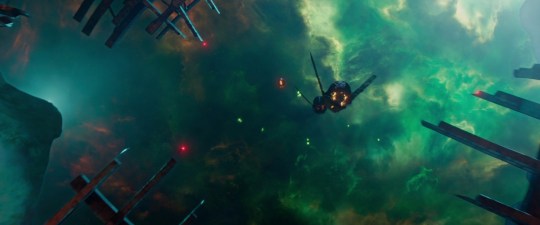
11 notes
·
View notes
Link
The seemingly unassailable world of the male creative genius seems to be crumbling: Roman Polanski and Bill Cosby were recently expelled from the Academy of Motion Picture Arts and Sciences, Junot Diaz stepped down as Pulitzer Prize chair after multiple women have spoken out about his pattern of harassment; and, 10 years after David Foster Wallace’s death, Mary Karr is reminding the world of his persistent abuse and stalking. In this unique social and political moment, a previously untouchable artistic archetype has finally become something close to vulnerable.
Genius is power. It is unquantifiable, uncontainable, and like beauty, exists in the eyes of the beholder. Genius enhances access—sexual, social, economic, political. It is a collective agreement—or, in many cases, a collective lie—that grants boundless latitude to those we anoint with the title.
But genius is also an indelibly gendered currency used by men—almost always men—of means and success to purchase license. The lie of genius is inextricable from the lie of meritocracy: Culture dictates that these men have risen to fame and success because of their unstoppable genius. But now that so many geniuses stand accused of abuses of power including sexual assault and violence; and as debates about separating the art from the artist spill into every corner of media and pop culture, the aesthetic alibi that artistic genius exists unfettered by lowly considerations like morality may no longer hold up under scrutiny.
With the rise of auteur theory in the mid–20th century, film joined the ranks of other fine arts, like painting and writing, that have long cultivated the mythology of the genius. Auteur theory, originating in French film criticism, credits the director with being the chief creative force behind a production—that is, the director is the “author.” Given that film, with its expansive casts and crews, is one of the most collaborative art forms ever to have existed, the myth of a singular genius seems exceptionally flawed to begin with. But beyond the history of directors like Terrence Malick, Woody Allen, and many more using their marketable auteur status as a “business model of reflexive adoration,” auteur worship both fosters and excuses a culture of toxic masculinity. The auteur’s time-honored method of “provoking” acting out of women through surprise, fear, and trickery—though male actors have never been immune, either— is inherently abusive. Quentin Tarantino, Lars Von Trier, Alfred Hitchcock, Stanley Kubrick, and David O. Russell, among others, have been accused of different degrees of this, but the resulting suffering of their muses is imagined by a fawning fanbase as “creative differences,” rather than as misogyny and as uncompromising vision rather than violence. Allegations that Tarantino forced Uma Thurman, for instance, to disastrously perform her own driving stunt in Kill Bill: Volume 2—as she put it, part of a dehumanization “to the point of death”—is not dissimilar to Alfred Hitchcock’s torment of the actress Tippi Hedren, both dynamics masquerading as artist-muse relationships transcending common sense. As Imran Siddiquee writes of genius directors and abusive behavior: “Many of the ‘greatest’ artists in our most influential visual artform continue to be celebrated for their own obsessive, often abusive exercises of power and control.”
Daniel Day-Lewis’s temperamental dressmaker Reynolds Woodcock in 2017’s critically lauded Paul Thomas Anderson film Phantom Thread has all the makings of a genius: He is successful; he is considered a visionary by the elite; he is messy; he is twisted; and he preys on young women. Phantom Thread was a frontrunner in the Oscars race this year, along with Darkest Hour, a character study of of Winston Churchill at the dawn of Britain’s entry into World War II. Gary Oldman (alleged wife beater), won Best Actor for his role as Churchill; elsewhere at the Oscars, Kobe Bryant (charged with sexual assault in 2003) won for best animated short. Guillermo Del Toro took home the Best Director Oscar for The Shape of Water, which also won Best Picture—and while the film’s win is notable given that no film with a female protagonist has won the award in 14 years, Del Toro’s explicit supportof Roman Polanski (accused of sexual assault by five people; charged with drugging and raping a minor and then fleeing the United States to avoid sentencing) make his position as a supposedly progressive director a tenuous one at best. The Academy Awards have always been deeply entrenched in establishment capitalism and Hollywood liberal lip service, but amid the flurry of the #MeToo and #TimesUp movements, the 2018 awards offered an instructive example of what still holds primacy in the film industry: the sometimes difficult and troubled, often abusive, and always male genius.
Men like Polanski retain artistic cred and social license because gatekeepers and fans argue that their cultural contributions outweigh their individual transgressions and crimes. It is not that passive consumers of art don’t recognize that their idols may be flawed: It’s that genius is imagined as a separate faculty that exists beyond ethics and morality. Genius is unemotional and objective, elevated beyond such paltry concerns. Of course the generous leaps of imagination and apologism offered to men of genius do not apply to women and gender-nonconforming creators, so if the latter should distinguish themselves, it is not because they are genius, but it is because they are “different.”
Superlative women have always been encouraged to believe they are notable because of an inherent “difference” from other girls; this difference is what distinguishes them in creative fields dominated by white men. I once thought I had the “androgynous mind” Virginia Woolf says is necessary to creativity. Mary Wollstonecraft, in her groundbreaking 1792 treatise A Vindication Of The Rights Of Woman, wondered whether the “few extraordinary women” in history were indeed “male spirits, confined by mistake to female frames.” Even Ursula K. Le Guin, whose revolutionary fiction challenged contemporary humanity’s preoccupation with gender, said some strange stuff about her own conception of herself as a “generic he,” a “poor imitation,” and a “substitute man.”
While we know it is both reductive and essentialist to reason this way, it’s historically understandable. The cultural misogyny that underlies the archetype of the male genius has ancient roots. According to Christine Battersby’s 1989 book Gender and Genius: Towards a Feminist Aesthetics, the 19th-century reworked an “older rhetoric of sexual exclusion” from Renaissance ideas about sexual difference in the arts (which were themselves based on the ancient Greeks and Romans). But the Romantics contributed something unique to “anti-female traditions”: While emotionality and expression—traditionally “feminine” attributes—rose in prominence, women themselves were further downgraded as artistic inferiors. Notes Battersby: “The Romantic artist feels strongly and lives intensely: the authentic work of art captures the special character of his experience.” And his art became his individualistic expression.
Originality and creativity wasn’t always inherent to artistic practice. Greeks thought of art as mimetic; the poet as a prophet; painting and sculpture pretty facsimiles of the natural world. The Middle Ages similarly viewed the artist as ungod-like, simply an imitator rather than a creator. The term “masterpiece,” had less to do with terrific originality and more to do with the “piece of work produced by an apprentice who showed sufficient skill.” A master was a “trade-union leader”—and women were active in these guilds as well. “Hostility towards women in the arts only increased when the status of the artist began to be distinguished from that of the craftsman…suitable only for the most perfect (male) specimens of humanity,” writes Battersby. She dates this change to when artists began gaining patronage during the Renaissance, freeing artistic creation from religious restrictions. In other words, when a great deal of money entered into the equation, art became profitable and it suited men to push out competition.
The modern term “genius” comes from the melding of two words: “genius,” a symbol of fertility represented by a little boy, and “ingenuity,” or skill. While Renaissance women lacked genius, they were artistic inferiors because they lacked “ingenium”—according to Juan Huarte’s 1575 Examen de Ingenius, men, in the Aristotelian fashion, were hot and dry; women, cold and wet, were a “lesser man.” (Aristotle also thought women were “flower pots” and sterile—creativity and procreativity both being male attributes.) Huarte’s physiological reasoning, though widely discredited, was later referenced by Schopenhauer, whose argument that women “lack all higher mental faculties” is a good example of Romantic reworking of cultural misogyny. (It might be worth noting that Schopenhauer is a well-known touchstone of Woody Allen’s many autobiographically based neurotic male protagonists.)
Further, madness and deviance were idiosyncrasies worked into the masculine artistic template. Artists, once expected to uphold societal values, became “countercultural” around the time of Lord Byron, who was once described by an ex-lover as “mad, bad, and dangerous to know.” The image of the antihero, the messy, the eccentric, the intoxicated artist persisted from the Romantic period through today. And while craziness was celebrated in the elite men, “female madness” was stigmatized. As Vox writer Tara Isabella Burton notes, the male artistic establishment begets the tortured, unruly genius sex: “That female flesh is the reward for a male job well done is not an uncommon cultural phenomenon in any field, but in the arts, that dynamic often takes on a faux-spiritual aspect.”
Even as the #MeToo movement picks up momentum, famous men who have sustained public critique in the past few months are already plotting their comebacks, with ample assistance from industry media. Tarantino, a man accused of choking Thurman and Diane Kruger for the sake of on-camera authenticity; who told Rose McGowan he used to jerk off to her; and who publicly defended Polanski, has unveiled his latest enterprise: a movie about Charles Manson. Charlie Rose has reportedly floated a comeback via a talk show in which he would interview men like Louis C.K. brought down by#MeToo—thereby facilitating their own comebacks—and Matt Lauer apparently hopes to be back on television screens as well. Despite the recent spate of high-profile falls from grace, the culture of media and art world are arranged such that neither whisper nor lawsuit will be able to fell geniuses for long.
Those who try to separate the art from the artist are setting up an illogical argument: The art was alwaysseparated, which is why these male auteurs had the the license, the support, and the cover to victimize as they did and still make more celebrated art. In the aftershocks of predatory unveilings, we have seen multitudes mourn the loss of the genius of these men. We need to now consider that we have elevated what we’ve inscribed as genius at the expense of the humanity and potential of people they silenced, erased, and preyed upon. We need to examine the destruction wrought by the archetype, and acknowledge that we have let it fuel rape culture and sexual exploitation. We need to acknowledge that genius has been a construct all along—that it may not actually exist.
1K notes
·
View notes
Text
Epilogues: Candy, Ch 16-21 [Epilogue 4]
So we’ve lost (spoilers will remain below the cut). This section starts progressing a lot faster, as the couples we’ve established all very rapidly start adopting kids. Jane’s whole eugenic vision, and fucked up relationships, starts coming much more to the forefront.
I call this the “we live in a society” chapter. Or perhaps the “edelman” chapter.
Chapter 16
At this point we get a six month time skip. Or for Terezi, a single day timeskip, because apparently there’s heavy time dilation between Earth C and the Furthest Ring.
The wedding itself is handled by recap, emphasising anecdotes. Of note is that Terezi is continuing to ghost basically the entire cast apart from John, which she claims is because he’s the most annoying.
In fact this entire chapter is text convos between John and Terezi, which is a nice return to early Homestuck when typing quirks were actually, well, typing quirks lol. Jane, it turns out, is now dating both Gamzee and Jake, which, well, ok.
ok.
ok.
anyway, there’s some wonderful dialogue on kismesis relationships at least:
TEREZI: Resentment can be fine in a short term black affair if the gaol is just to fill pails and avoid culling.
TEREZI: But in a sustained romantic rivalry it will always spell ruin.
TEREZI: Just like in a caliginous relationship, how it’s important for you to be able to communicate with your kismesis.
The rest of Terezi’s dialogue, talking a bit about Vriska, is a joy to read. I miss Terezi.
Oh yeah and Roxy’s pregnant. That’s important! Their wedding was 6 months prior, though it’s not clear from the narration when their baby was conceived.
Chapter 17
Another three month timeskip. That means nine months from the wedding - just about long enough for John and Roxy’s baby to be born.
Rose and Kanaya have outright named their child Vriska, which is... ok she may be a clone but that’s one hell of a thing to put on a kid, fucking hell.
Like, just wow. Imagine knowing Vriska and deciding to not just adopt her clone but name her clone after her! I take back whatever dumb shit I was saying about Rose and Kanaya being well adjusted. Poor kid.
There’s an amusing conversation in which Kanaya has misconceptions about how human children are born - from Karkat, via Dave. This is really going hard on the whole reproductive futurism angle huh.
The question of Vriska’s name comes up. Rose says that Vriska defeated Lord English - apparently having entirely forgotten all the things she said before, about how that whole plot point of how he was ultimately defeated was unresolved.
JOHN: rose, no one knows what happened to lord english.
ROSE: Of course we do. Vriska used the juju and her accompanying ghost army to defeat him.
ROSE: Why else would we be here?
JOHN: i don’t think that’s what actually happened though!
KANAYA: Then What Did Happen John
JOHN: i... i JUST said! JOHN: no one knows!
So uh... it’s like there’s some all-encompassing force, pushing the kids towards a “happy ending” defined in terms of pairing up and raising kids, editing their memories to leave nothing unresolved... and only John seems to be immune?
And moreover, whatever this force is, it seems to have robbed Roxy of her independent will. She’s going along with whatever John wants - much to his consternation.
Everyone is contorting themselves into a standardised template of “adulthood”, focused on reproduction above all, telling themselves it will make them happy... even the lesbians!
(Is this all one massive attack against the Harry Potter epilogue lol)
Chapter 18
In this chapter, Jane explains the need for eugenics to Gamzee. She insists that, if trolls were allowed to outbreed humans, the ‘natural’ Alternian social order might assert itself. It’s not racism! Some of her best friends are trolls!
Gamzee suggests this might get her ‘cancelled’, and she calls him ‘a literal insect in clownface’. Because she’s totally not xenophobic or anything. They have kismesis-hatesex, which includes...
In spite of Jane’s protests, Gamzee makes a desperate play for a lusty squeeze. Jane puts up a valiant show of resistance, but Gamzee knows she has no real intent of fighting him off—it’s all part of the kismetic dance. He has his big clown mitts right on her busty bags, honking away.
...what feels to me like a dangerous blurring of consent lines. Bottom line: this relationship is all kinds of fucked up...
Also why did I have to see the words “busty bags” with my actual eyes.
Not sure what the story is going for with this troll eugenics plotline. Jane explicitly tries to draw a line between this and actual racism insofar as there are, she says, actual biological differences between humans and trolls such as birth rate, unlike human ‘races’ (the story does not deviate from the idea that the kids are ‘aracial’, incidentally, though it’s hard to take Jane as anything other than white the way she acts). But why does the narrative feel the need to go there? I guess it’s about Jane’s character specifically; the not-so-subtle fascism in her whole image as a ‘proper’ businesswoman. She’s just doing what needs to be done!
I recall that ‘prison camps’ was up there in the content warnings list.
The latest Homestuck Baby is named Tavros. Naming babies after your dead friends is all the rage these days!
The narration stays with Jake as he leaves the room, but we still hear more than we’d like of Jane and Gamzee fucking.
The subject of kids - the REPRODUCTIVE IMPERATIVE - comes up. Jade explains that merging with Beq has done something to her bits, so she won’t be getting pregnant. And nobody’s really feeling ectobiology. Though that’s probably not the biggest issue with her and Dave...
She says she’s discussed surrogacy with Rose, and neither Dave nor Karkat would be ‘the father’ in this scenario. Ah, I think I see where this might be going. Beq was a male dog, as I recall.
(so this is basically... V Homestuck, apopros of nothing: do you know i think jade probably has a dick)
Chapter 19
In accordance with our headlong rush into families and reproduction, John has started working on becoming his dad I guess? He has a moustache, and even carries a briefcase.
New world, new social order... or not, I guess.
Anyway, the troll racism/eugenics metaphor is really speeding up:
KARKAT: JADE, DON’T YOU READ THE NEWSPAPERS?
KARKAT: THE NEW ADMINISTRATION IS CRACKING DOWN ON CERTAIN KINDS OF INTERSPECIES ADOPTION LAWS.
KARKAT: IF YOU’RE SO INTENT ON IT BEING “THE THREE OF US,” WE LITERALLY WILL NOT BE ABLE TO ADOPT A HUMAN CHILD BECAUSE THE HUMAN ADMINISTRATION IS AFRAID THAT I’D...
KARKAT: I DON’T KNOW.
KARKAT: TEAR INTO IT, AND FEAST ON ITS ORGANS.
KARKAT: AND IN THAT KIND OF POLITICAL CLIMATE? WELL, I’M NOT SURE IT’S A WORLD I WOULD WANT TO RAISE A TROLL CHILD IN RIGHT NOW.
Later on they outright call Jane a fascist. Not beating about the bush here. And John has apparently described Jane’s treatment of Jake as outright rape, which his friends generally assent to.
Thinking I should have picked up more of that dynamic when I read the earlier Jane/Jake scenes. There was a line...
It’s not the most rousing speech Jake has ever given, but it seems satisfactory enough for Jane. He releases a tremendously relieved sigh when Jane breaks into a smile.
JANE: Oh, Jake!
He flails when she kisses him. But this time, there’s no doubt he hasn’t said no.
Yeah that pretty much made it clear didn’t it. Jane has absolutely no regard for Jake’s will; and Jake is in no way in this situation able to assert how much this dynamic is harming him, without Jane pulling out the same manipulative tricks, playing hard on his ridiculous ‘old-timey gentleman’ thing.
Anyway, any discussion of their own relationship is forestalled when a dead body of Jade falls from the sky! Apparently it’s a much younger version of Jade - the origin is utterly unclear. (Perhaps we’ll find out in the Meat storyline?)
Whatever the cause, it prompts Jade to go to Jane - whose Life powers could bring the dead Jade back, in theory.
Chapter 20
But Jane’s powers... don’t work at all. (Also her relationships are pretty dire and she’s exerting fascist influence behind the scenes). Apparently whatever’s afflicting this Jade is more fundamental than poison: a ‘metaphysical’ rot. Meanwhile, it’s heavily implied (as was more or less said outright earlier) that Rose’s Seer powers don’t work anymore.
Jade wonders if her presence in Earth C implies the other selves across other timelines can no longer exist. But this is maybe only brought up to dismiss it.
Instead, Roxy brings up the whole fascism thing - as a political divide pushing them apart (metaphor ahoy). Which prompts an impassioned - and justified - rant from Karkat. Gamzee steps in, and Karkat has a go at him too, and the way he’s exploiting his claimed ‘redemption’:
KARKAT: NO.
KARKAT: NEVER IN THE WILDEST DREAMS OF YOUR SOPOR SOAKED PEABRAIN WILL WE BE “MOTHERFUCKING GOOD,” GAMZEE.
KARKAT: BECAUSE YOU’RE SLEEPING WITH THE GODDAMN ENEMY.
KARKAT: BECAUSE I STILL HAVE NIGHTMARES ABOUT WHAT YOU DID.
KARKAT: AND BECAUSE YOU HAVE NO IDEA WHAT THE FUCK YOU EVEN DID WRONG IN THE FIRST PLACE!
In the framing this story has developed, he’s not wrong, obviously. The words ‘redemption arc’ are thrown out again by Roxy and Jane in Gamzee’s defense, and Karkat storms out.
Karkat is good in the role of moral authority, directly confronting cruelty and hypocrisy that his more ‘polite’ friends would rather sweep under the rug in the name of unity. We see their reactions:
Karkat leaves a stunned silence in his wake. Jane fuming silently to herself, Kanaya and Rose exchanging a knowing look about World Politics, John chewing his lip and mulling about how Karkat is probably right, and how if he were braver, he would have backed him up.
Kanaya and Rose - on the ‘right side’, but in many ways, the middle class, above-it-all. John, the coward. Jane, put on the spot, soon falls back on her ideals of propriety...
Karkat’s ancestor was the Signless/Sufferer, who led a rebellion against the Condesce. Perhaps he’s stepping up to fill a similar role...
Chapter 21
As was discussed in the prior chapter, Roxy insists on holding a funeral for the dead alternate-universe Jade... for the sake of unity, or something. This works about as well as you might expect.
Oh, and, on the subject of Jake and Jane, well.
You gave it the old college try chap, Jake said to him earlier as he waxed his mustache in the mirror. But its better for a man to just let his wife do whatever she wants. I promise youll experience less pain that way old boy.
yeesh
Also Calliope is here! She gives a little speech about death, and shares a tender moment with Roxy... so... still playing into that ambiguity huh.
Then Aradia and Sollux show up?? I guess they were, technically, still alive! They have not, indeed, been absorbed by the big black hole... and they certainly liven things up.
Honestly, the massive pileup of characters leads to them playing off each other in ways I’ve really missed. It’s like a good old classic homestuck group chat feel.
Roxy gives a speech that’s ultimately all about Dirk - about the ways things might have been different, whether it’s even meaningfully possible to compare. Good old Homestuck themes. Then she has her actual baby because why not.
As if this isn’t enough melodrama for one chapter, Jade’s ‘corpse’ gets up, and reveals it’s not actually Jade in there at all, but... someone who speaks in red text, and is known to Calliope. Alt-Calliope perhaps..?
Sure enough, it is... the Calliope who predominated over Caliborn in an alternative branch of that timeline, who created the big black hole, and who has now arrived ‘to protect your world’.
Phew.
Epilogue 4 as a whole
Bloody hell that was something.
So Jane’s gone full fash. For significant chunks of the comic she was mind-controlled by the Condesce, but I guess within this story she’s capable of going fash on her own devices.
The awful relationship between Jade and Jake is well-realised, I think, for all its awfulness. It comes across as a believable, ugly dynamic.
The whole redemption arc thing, that keeps coming up - it’s about fiction, but perhaps also more broadly about transformative and restorative justice; the kind of difficult conversations that I struggle with a lot, of how we collectively and individually respond to instances of cruelty, abuse and violence, and how these things arise in the first place.
At its best, this story is challenging a perspective that people who have been hurt in terrible ways should be obliged to grant forgiveness and absolution; a ‘too easy’ story where all pain disappears and everyone can just be friends again. But we must avoid two failure modes: one is a model of the world which takes it that some people are just bad, justifying any extent of “retributive” violence, and systemising that in a way that can and will inevitably be directed as a further weapon against those who are vulnerable to it, rather than in any way that prevents harm. All expansions of prisons are justified by appealing to the worse “predators”, but they do basically nothing to prevent sexual violence (rather, they concentrate it) and instead conveniently provide slave labour.
But there is still an obvious danger in the presumption that someone who has learned to be abusive and controlling has ‘reformed’; of refusing to act when someone needs help. Any system can be exploited.
Note that, of course, there is a considerable gap between imprisoning Gamzee in a fridge, and welcoming him as part of the friendship circle. When practised on a community scale, exile is an instrument of violence, but no individual person or small friendship group is obliged to maintain a relationship with a particular person...
So that’s what it’s dealing with. Only with ‘lol this clown is gross’ jokes; Gamzee, as presented here, is a repulsive person in every way possible, and those who defend him are painted as idiots.
The whole thing with the clowns in Homestuck has always been a bit of a weird one. The cultural markers invoked are heavily associated with class: they’re dirty, they drink a lot, they’re literally juggalos. But they’re also declared to be the ruling class, relating to other trolls as oppressors. And of course, haha, it’s only jokes, right...
(That’s not to get into the extent that clown imagery is racialised in the US, because hoooo boy that’s a complicated one. Discussions of ‘coding’ in media can get horribly oversimplified, and I think I’ve put my foot in that elsewhere. Coding is never just one thing)
Anyway I’m probably like, going on too much about this. Tell me I’m full of shit lol.
Alt-Calliope is hopefully finally going to explain wtf is going on as a result of John’s dubious decision at the start.
3 notes
·
View notes
Photo

“Bumblebee” Movie Review
Bumblebee is the latest film in the Transformers live-action film franchise, and yet functions as something of a soft reboot by way of prequel to that series. It stars Hailee Steinfeld as Charlie Watson, a young teenage girl growing up in 1987 near San Diego, California. When Bumblebee, a transformer from the planet Cybertron, is sent to Earth by the Autobot leader Optimus Prime in order to establish a base from which the Autobots can mobilize to save their planet from the Decepticons (against which a war has been raging on Cybertron for some time), he lands near this area, and is soon damaged in battle by a Decepticon who followed him. A while later he is found by Charlie while she’s scavenging for car parts in her uncle’s junkyard to fix up a Corvette her and her father were working on before his untimely passing. Soon, the two form an unbreakable bond between man and machine, and both get taken by the other on the adventure of a lifetime.
The Transformers live-action franchise up to this point has had, needless-to-say, a troubled relationship with fans of the characters. Some genuinely love Michael Bay’s takes on the robot action spectacles (even I’ll defend his first outing in 2007 as at least pretty good, although certainly imperfect), but most people recognize that the overly sexualized female characters, over-reliance on low and dutch-angle cinematography, oversaturation of color, and spectacularly offensive screenplays aren’t exactly the best fit for a franchise that made its name by being an entertaining show for children. People needed someone who would not just set the franchise right, but also deliver a good story worthy of the original cartoon people fell in love with in the 80’s. Enter Travis Knight, director of 2016’s excellent Kubo and the Two Strings. And exit with a franchise-best film that not only recaptures the heart of what makes the Transformers so fun to watch, but boasts a genuinely good 80’s-style coming of age story to boot.
Yeah, there’s no joke here guys, Bumblebee is a genuinely good throwback to 80’s coming-of-age movies just as much as it is a much-needed course correction for the Transformers franchise, and I actually kind of adored it. It’s not perfect (in fact there’s a whole military subplot involving John Cena that gets a little hammy even if it is done intentionally and the overall plotting is a little too similar to Spielberg’s E.T. for anyone familiar with that film not to notice), but it rides the line so perfectly between accomplishing what it needs to and maybe not caring that it needs to accomplish anything in particular that one wonders why it wasn’t Paramount’s first choice to just get someone with a strong background in animation and character development like Travis Knight (one of the chief personalities at LAIKA) to helm the franchise from the start. Knight’s direction is nearly pitch-perfect here, as he keeps the movie contained and small-scale, focusing on the relationship between Charlie and Bumblebee to drive the film’s central story.
Now, don’t get me wrong, that’s not all this movie has going for it, but keeping it focused on that central relationship gives that relationship a weight no other Transformers movie has had up to this point (unless you were particularly attached to Shia LaBeouf yelling “Optimus” at a green screen every couple of hours). And it’s a really charming relationship to watch. Steinfeld is actually really good here as Charlie, hitting the emotional moments right when she needs to and making it pretty easy to forget that she’s actually talking to nothing most of the time given Bumblebee’s CGI…ness (that may not be the right term, but it’s the one I’m going with for now). I’d even go so far as to say it’s her best performance since 2010’s True Grit remake that was actually pretty good and not enough people talk about. Some of the 80’s-style comic elements of the film don’t sit the best with the kind of performer she is right now, but she makes the script work enough that you come to genuinely care when she gets hurt or when she’s in pain because Bumblebee is. Of course you wouldn’t care at all if the title character wasn’t compelling in his own way, and the filmmakers do this pretty well.
Bumblebee is a charming, delightful treat in this movie, and it’s very clear the animators and visual effects artists went to great lengths to make sure people could tell he was a Transformer by doing little things like making his chest plates the front head panels or putting the doors and wheels on his back. The visual work in this is pretty great and helps clear up a lot of the confusing during some pretty great action sequences as to who’s fighting who or who’s standing where. The damaging of Bumblebee’s voice in one of the film’s opening battles challenges the animators to have to make the character more compelling, given that he can’t really communicate the way he used to, and the facial animations that result from this challenge are a genuine marvel to behold, even if only because they’re stripped of all the clutter that came before in the Bay films.
That’s another thing this film does pretty well: it doesn’t really add a whole lot of its own material so much as strip away everything that didn’t work before, and it encapsulates this by throwing the setting all the way back to the era that Transformers worked the absolute best in, because if you’re going to model all your designs and storytelling after the era that worked best, why not throw the whole movie back to that very era? This movie actually feels like an 80’s Transformers cartoon brought to life, and while that may hurt some aspects of the film like some opportunities where more nuanced could be useful and a few cartoon-like human characters, it mostly just adds to the charm of the whole. The biggest flaws have already been addressed, like the script being too similar to E.T. (although if you’re going to use an 80’s script as a template for this, there are worse choices) and John Cena’s military sub-arc being a little bit hammy (even if it might be on purpose), but those are really the only ones that last once one thinks about the film post-viewing.
In the end, this movie didn’t necessarily surprise me given that I knew who was helming it and starring in it (and they’ve all done great work before), but I did breathe a sigh of relief when it was done. Bumblebee may not be the next E.T. or major effects blockbuster to transcend what it is to become a cultural phenomenon or Oscar-worthy classic of the genre, or even a particularly great movie, but it is a genuinely good one, and that’s all it needs to be right now. Finally, there’s a Transformers movie that actually respects character relationships and telling a good story before it even thinks about spectacle. Finally, the action sequences don’t look like a jumbled mess of CGI where no one can tell what’s going on or who’s who. Finally there’s a director in charge who has a passion for these characters that’s reflected in his work. And it’s all lead to what is by far the best Transformers movie yet.
I’m giving “Bumblebee” an 8.8/10
#Bumblebee#Movie Review#The Friendly Film Fan#Film#Movie#Review#Transformers#Hailee Steinfeld#John Cena#Travis Knight#Jorge Lendeborg Jr.#John Ortiz#80's#New#2018
5 notes
·
View notes
Text
The “Daryl as a Mary Magdalene-figure” theory
Part two:The Da Vinci Code, “The Last Supper”, glass pyramids, greenhouses
In my opinion, TPTB’s effort to establish Daryl as a Mary Magdalene figure essentially start in 4x13 “Alone”. This is also the episode where the “The Da Vinci Code” references become really obvious. The episode starts with a musical montage where we follow Bob right before he is found by Daryl and Glenn. We see him wandering around on his own, looking lonely and depressed. At one point he builds some sort of “cage”, so that he can later sit in it and drink his cold medicine (Cold-Z, a “cooler” reference, keep this in mind until later). We then watch him climb on top of a trailer (@wdway reminded me of the fact that this trailer is identical to the wolf trap trailers in 5x16) and we get this shot:

This seems like a good time to say a few words about “The Da Vinci Code” plot. Our hero, Robert Langdon, is called to the Louvre museum in Paris to assist in the investigation of the murder of the museum curator Jacques Sauniere, whose dead body is posed like The Vitruvian Man, a famous sketch by Leonardo Da Vinci.
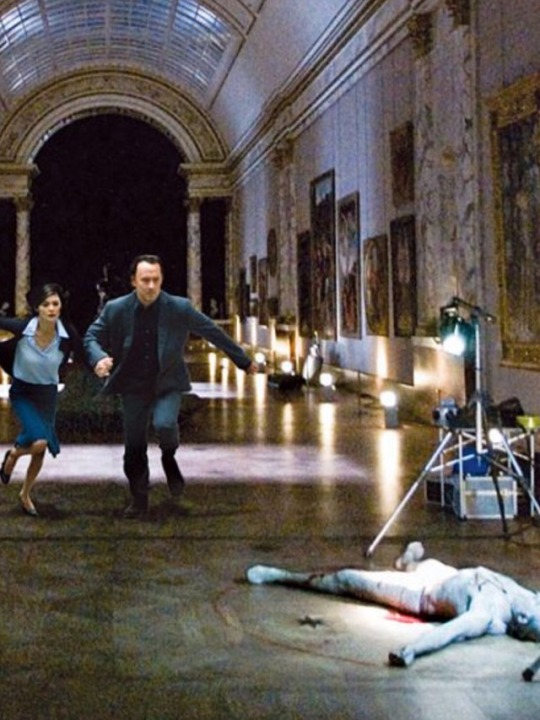
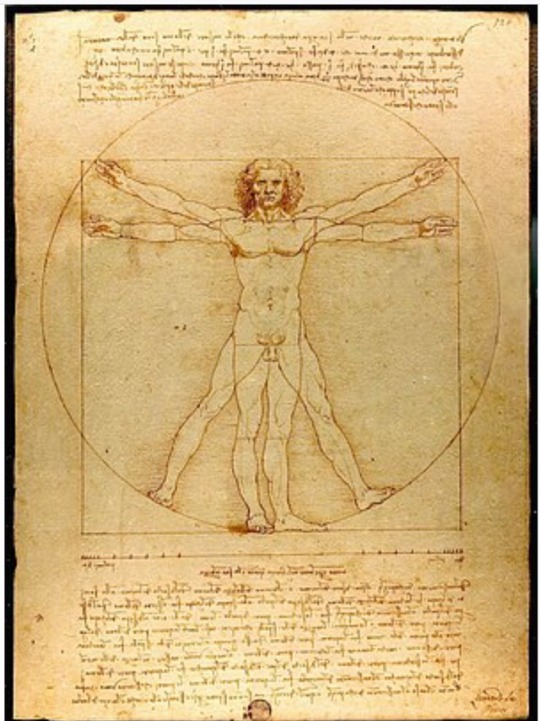
Back to TWD. Bob’s pose in “Alone” is similar to both Da Vinci’s “Vitruvian Man” and Jacques Sauniere’s dead body in “The Da Vinci Code”. This, in my opinion, indicates that TPTB intentionally inserted TDVC imagery into this particular episode of TWD. And there is a good reason for that.
The premise of TDVC is that Mary Magdalene and Jesus were in a relationship, had a child, and that the Merovingian kings of France were descended from the bloodline of Mary Magdalene and Jesus. Throughout history, this secret was protected by a series of prominent characters such as Da Vinci himself, who according to The Da Vinci Code inserted certain clues in the painting “The last supper”. The most central clue suggests that the character officially recognized as the disciple John in reality is Mary Magdalene. With that in mind, one can see how it is easy to compare the painting to the White Trash Brunch/kitchen scene from “Alone”, like here:
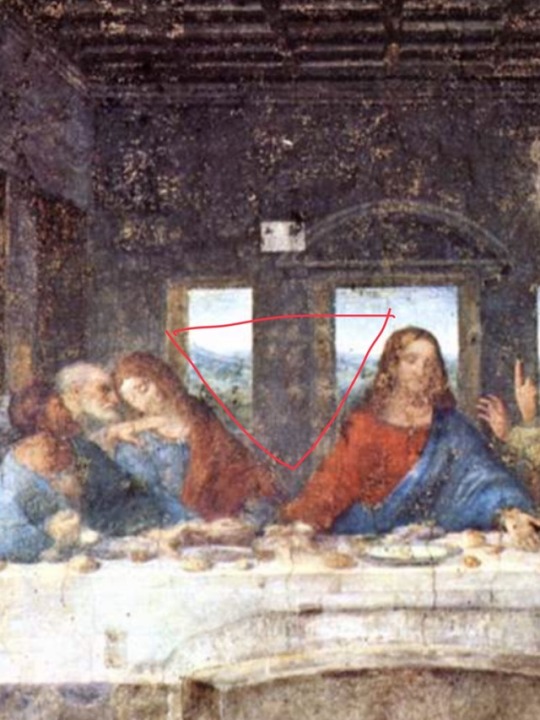

In addition to the similarities between “The White Trash Brunch” and “The Last Supper”, comes of course the shot of Daryl taking a good, long moment to admire the plaque of “The Last Supper” in 5x2 “Strangers”.
From a TD perspective this is interesting because it is yet another way of establishing Beth as a Christ figure. From a Bethyl perspective it is interesting because if there is a TDVC template in “Alone”, one has to remember that in TDVC Jesus and Mary Magdalene were actually romantically involved. Mary Magdalene was Jesus’ love interest, and if Daryl is Mary Magdalene to Beth’s Christ, it also suggests that Daryl is Beth’s love interest. Furthermore, in many accounts from early Christianity Mary Magdalene is the first person to see the resurrected Christ, something which calls for interesting speculations in terms of who will be the first person from Team Family to see the “resurrected” Beth.
The TDVC template doesn’t end with the kitchen scene. In TDVC, after Robert Langdon has solved numerous mysteries across all of Europe, in the final pages of the book he follows “The Rose Line” a fictional name given to the Paris meridian line, in search of the “Holy Grail”. He suspects that if he follows “The Rose Line” it will lead him to it, and he eventually realizes that the Holy Grail is the bloodline of Jesus and Mary Magdalene. The relevance to TWD, TD and Bethyl is that “The Rose Line” has lead Robert Langdon to the inverted glass pyramid outside the Louvre Museum, and he realizes that Mary Magdalene’s sarcophagus is secretly hidden underneath the smaller pyramid below the inverted glass pyramid.

In 6x6 “Always Accountable” Daryl is initially taken captive by Dwight and Sherry. When Tina has an accute illness incident and faints, Daryl takes the opportunity to escape. He runs through the woods, before he eventually stops to untie his hands and get his crossbow ready to take down an approaching walker. As the walker falls, we see a Cherokee rose attached to its back, and it is as if the sight of the rose change Daryl’s attitude towards the situation. He notices a cooler containing insulin, and decides to return the medicine to Tina who is obviously in a bad place without it (take note of the cooler, it’s part of a “cooler” theme I will expand on later)
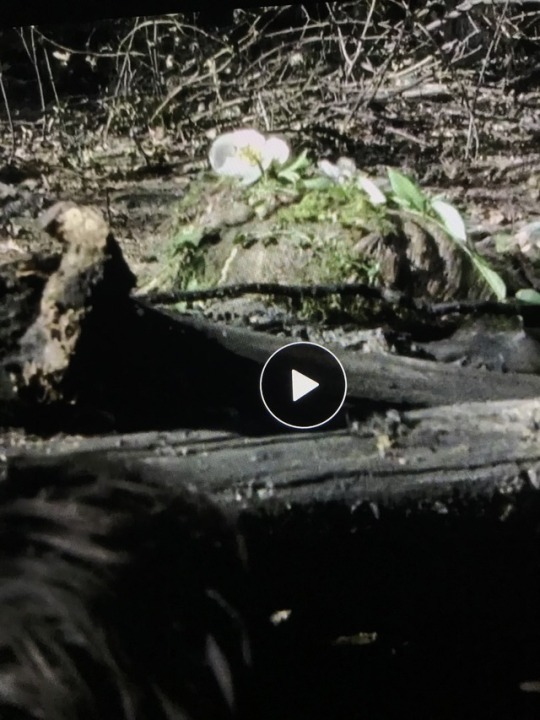
So in TDVC we read about Robert Langdon following The Rose Line through Paris, eventually realizing that The Holy Grail is the bloodline from Mary Magdalene and Jesus, and that the sarcophagus of Mary Magdalene is secretly hidden under the smaller pyramid below the inverted glass pyramid by the Louvre Museum.
In TWD, there aren’t any inverted glass pyramids, but we do have a recurring theme of greenhouses (glasshouses) with holes through the roof.
Think back to the greenhouse with the hole through the roof in 4x4 “Indifference”, when Rick and Carol come across Sam and Ana. They aren’t really the surviving kind, but before she dies Ana makes sure to emphasize that there’s a greenhouse there with a hole through the roof, so that the water can come in and the fruit can grow. It seemed like an incredibly random storyline at the time, but nothing is random in TWD.

Also think back to the greenhouse “tomb” in 6x6 “Always Accountable”. Think about how there’s a Cherokee Rose that leads Daryl to turn around and return the insulin to Tina, Sherry and Dwight.

Think back to the greenhouse with the hole through the roof on 4x4 “Indifference” and the greenhouse “tomb” in 6x6 “Always Accountable”. Think about how there’s a Cherokee Rose that leads Daryl to turn around and return the insulin to Tina, Sherry and Dwight. Think about how the Rose Line through Paris eventually led Robert Langdon to Mary Magdalene’s sarcophagus underneath the inverted glass pyramid outside the Louvre. Think about how the holy grail turned out to be the bloodline from Mary Magdalene and Jesus. Think about how the Cherokee Rose, that represents hope of finding lost loved ones, led Daryl to return the insulin to Tina, so that she was able to properly control her blood sugar, “wake up” from her almost unconscious state. The Cherokee rose eventually led him to ...not a glass pyramid but a glass house/greenhouse with a hole through the roof. There are some clear parallels between TDVC and TWD here.

In TDVC, Mary Magdalene’s sarcophagus was revealed to be hidden under the inverted glass pyramid in front of the Louvre museum. A pyramid is a tomb. We haven’t seen glass pyramids in TWD, but we have seen glass houses/greenhouses. We’ve seen “glass-sarcophaguses”. We haven’t seen Mary Magdalene’s sarcophagus under a pyramid below an inverted glass pyramid (tomb), but we’ve seen Daryl in a coffin in a funeral home. And we’ve seen Beth and Daryl share the trunk of a car, universally accepted by TDers everywhere as a foreshadow of something that happened off screen during those missing 17 days, something which ended with Beth for some reason being “gone”, something that no one talks about, something that was “hinted to” by having Maggie find the Beth-walker in the trunk of a car in 5x10 “Them”. And we’ve of course also seen the car with the white cross drive away with Beth, leaving a panicked and heartbroken Daryl to chase after it all night.
To be continued in part three
9 notes
·
View notes
Photo
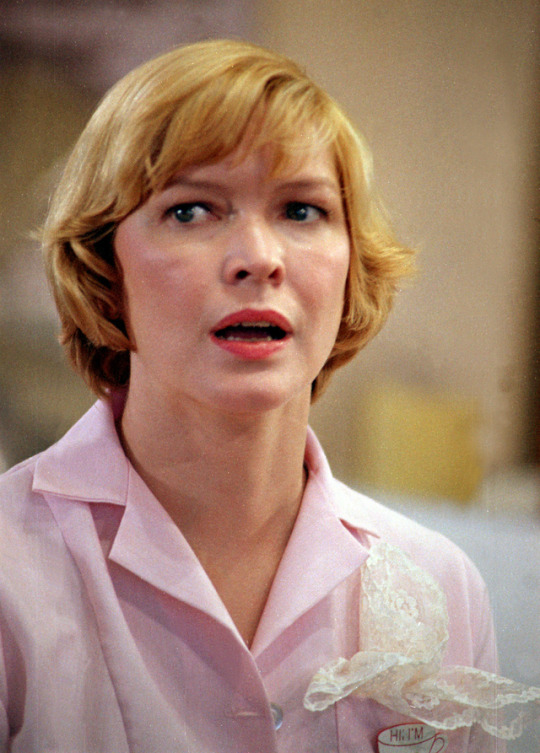
Learning the Ropes: Early Scorsese by R. Emmet Sweeney
Martin Scorsese is not just a name, but a phrase that conjures a world of lower east side street corners, Italian-American toughs and mob rituals. He has built a remarkable resume over 50 years of filmmaking and preservation work that has managed to retain outsized artistic ambitions as Hollywood’s continues to shrink. He has become a living institution, which can sometimes obscure some of the work that built that reputation. FilmStruck is programming three early Scorsese films to re-acquaint ourselves with a portrait of Scorsese as a young director: WHO’S THAT KNOCKING AT MY DOOR (’67), MEAN STREETS (’73) and ALICE DOESN’T LIVE HERE ANYMORE (’74). Today I am writing about the two lesser-known films, WHO’S THAT KNOCKING and ALICE, which show Scorsese inhabiting and reaching beyond his roots.
WHO’S THAT KNOCKING AT MY DOOR took four years for Scorsese to make and get into theaters, first conceived in 1965 while he was still an undergrad at NYU. He received $5,000 in seed money from his professor Haig Manoogian (listed as a producer). It was intended to be the second part of a trilogy in which MEAN STREETS would be the conclusion. The first being the never-produced JERUSALEM, JERUSALEM. The trilogy was to be a semi-autobiographical story of a lower east side NYC striver named J.R. (Harvey Keitel in his first feature – he was making a living as a court stenographer), hanging out in social clubs in between short-term jobs, hoping for a break. The film went through many variations, first as a short film called Bring on the Dancing Girls, which was then incorporated into a feature called I Call First (where it premiered at the Chicago International Film Festival and was positively reviewed by Roger Ebert).
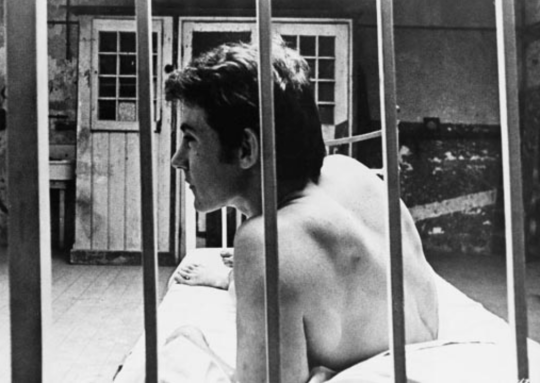
It received its final form after sex film distributor Joseph Brenner agreed to pick it up if Scorsese would add some nudity. Scorsese described to Anthony DeCurtis in 1991: “We shot it in Holland, because I was up in Amsterdam doing some commercials for a friend of mine. We flew Harvey [Keitel] over and we got the young ladies there and we did this nude scene. I came back, kind of smuggled it back into the country in my raincoat, put it in the middle of the film and then the film was released. But it was still a rough sketch to me…ah, it’s the old story: if I knew then what I know now it would be different.”
The film follows J.R. as he kills time with his buddies at their social club and at bars drinking the hours away. But there is also a flashback to J.R.’s fractured relationship with a girl (Zina Bethune) he picks up while waiting for the Staten Island Ferry. She reads F. Scott Fitzgerald while he is an expert in Westerns. Their first conversation revolves around John Ford’s THE SEARCHERS (’56), since there is a photo of John Wayne in the French magazine she is reading. They swiftly fall in love, but J.R. is still something of a child, prone to outbursts and totally uncomprehending that a woman can have an inner life of her own. When she reveals that she has been sexually assaulted, instead of offering solace, J.R. is repulsed, his Roman Catholic upbringing thumping in his brain, telling him she must have brought it upon herself.
Scorsese, deeply under the spell of the French New Wave, proceeds with a heavy use of jump cuts, though here it feels like less of a rhythmic element and more of a way to stitch together disparate footage shot years apart. He was lucky enough to hire Thelma Schoonmaker right off the bat, but here was a reclamation job she could not entirely succeed at. But there is remarkable skill and daring on display here, especially in the use of slow motion, superimposition, and especially in the use of music. The closing montage is a quick-cut portrait of a Roman Catholic church, with The Genies’ “Who’s That Knocking” plastered on the soundtrack, forcefully displaying J.R.’s inculcated roots in the church, the source of his warped views on women, as well as his interest in breaking free. Early on he begs his social club boss Joey (Lennard Kuras) to go get a drink in the Village, and is rebuffed. The Village, and later, the Girl played by Zina Bethune, are symbols of escape. But he doesn’t really understand either. He is shocked when the Girl is upset when he “forgives” her for being assaulted, and retreats back to the cocoon of Joey and his neighborhood pals. There is an extended take at the end of a bar – where J.R., Joey and a young kid they dismissively call Sally Gaga (Michael Scala) sit and laugh. They toss napkins at each other, like high-school kids at lunch having spitball wars. They are still, for all intents and purposes, children. And yet they have been loosed upon the adult world and the poor women who will have to suffer their notions of Catholic guilt.
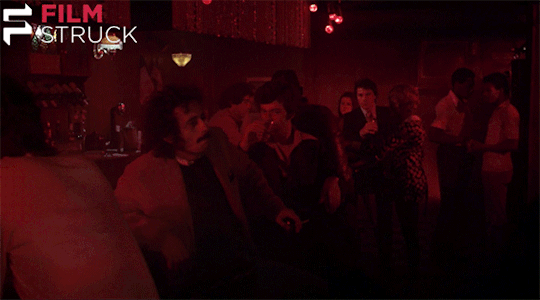
After MEAN STREETS, Scorsese was a hot commodity and instead of doubling down on small time NYC crime stories, he shifted gears into a sweetly romantic road movie – ALICE DOESN’T LIVE HERE ANYMORE. Instead of NYC, it’s the sunbaked climes of New Mexico and Arizona, where a struggling single mom and singer (Ellen Burstyn) is trying to make her way to California to make a living for her son. Opening with credits in Academy ratio and a booming Miklos Rozsa-esque score, it’s clear this is Scorsese’s attempt at a Hollywood melodrama in the Douglas Sirk mode, only filtered through the New Hollywood sensibility.
Ellen Burstyn approached Scorsese to take on the project. According to the AFI Catalog, she had received the script by Robert Getchell from Warner Bros. president John Calley, and though it had been passed over many times, Burstyn was attracted by the character of Alice. Coming off of THE EXORCIST (’73), she was given her choice of director, as well as final script approval (she also advocated for more women to be hired on the crew, including editor Marcia Lucas and art director Toby Carr Rafelson). MEAN STREETS had not been released yet, but it was getting strong early reviews and the two hit it off. They worked on improving the script together and participated in extensive rehearsals and improvisations (the bit about Alice’s first stage act was Burstyn’s improvisation, drawing on her real-life act with her brother).

The movie begins with a fairytale, WIZARD OF OZ-like back lot set, a pigtailed girl walking down a lane to her clapboard house, only this time with way more cursing. It’s a cutesy way to introduce the character of Alice, who is a combination of sweetness and a salty mouth. The film is really a showcase for Burstyn, who appears in nearly every scene, giving a performance of gallows humor and deep pathos. She establishes a natural rapport with Alfred Lutter, who plays her son Tommy. Their relationship is one of mutual needling and teasing, one that can ratchet up to anger at moments of extreme stress. At one of Alice’s low ebbs, when she has to postpone her singing career to take a job as a waitress, they let off steam by getting into a water fight. It escalates from a little joke into a full-blown soaking for both, a diversion of stress into play violence. The duo become expert at coming up with games to lessen the anxiety of their tenuous economic existence. And like on WHO’S THAT KNOCKING AT MY DOOR, the soundtrack provides not just a backbeat but insight into the characters’ lives, from Tommy’s blasting of Mott the Hoople to sensitive-boyfriend type Kris Kristofferson’s mellow take on “I’m So Lonesome I Could Cry.”
Where WHO’S THAT KNOCKING AT MY DOOR provides the doomed tough guy Scorsese template that he would elaborate on for the decades to come, ALICE DOESN’T LIVE HERE ANYMORE shows he could apply his talents just as skillfully to the melodrama, as he would occasionally detour to explore again in films like THE AGE OF INNOCENCE (’93, newly out on Blu-ray from Criterion). So while the crime films will always be synonymous with Scorsese, the TAXI DRIVER (’76) and GOODFELLAS (’90), we should expand that association to include ALICE right alongside them.
#FilmStruck#Martin Scorsese#Alice Doesn't Live Here Anymore#Who's That Knocking At My Door?#StreamLine Blog#R. Emmet Sweeney#Ellen Burstyn#Harvey Keitel
52 notes
·
View notes
Text
Dating Sites With Trans Option
Brook Shelley’s previous work for The Toast can be found here, and our previous coverage of trans* issues can be found here.
Hearing about people being afraid of or not open to dating a trans person is just one reason why it is so hard to date as a trans person. And even though I have heard it many times before, it is still hard to confront. I looked at eight popular dating sites to see which are the most gender inclusive. Dating only trans people, at least here in my local community, do not seem like a realistic option since we are too few. Finding the right person would be next to impossible. Well, that was my 2 cents on that. I,m actually surprised by the comments so far. TRANSGENDER, PANSEXUAL, LESBIAN, GAY, GENDER-FLUID, Bi-SEXUAL & NON-BINARY DATING SITE & SUPPORT. We are a Transgender, Pansexual, Lesbian, Gay, Gender-fluid, Bi-sexual & Non-Binary dating site where you can find support, make friends, talk to others about their journey, look for love and so much more. Reddit’s r/t4t subreddit is essentially a personals-style online dating forum for transgender people. While it’s not as detailed as more established trans dating sites, this subreddit is designed.
Welcome to lesbian trans womanhood. I know, we aren’t supposed to say that. Welcome anyway. Let’s assume you know two things: that you are a woman, and that you like other women. Good. That’s a fine place to start. Follow along, and we will get you from this humble beginning, to being a real-live dater.
Take a deep breath. Ready?
1. First, lower your expectations. Whatever you think might happen in the next few paragraphs, or in the next few months, expect less.
Dating Sites With Trans Options
This isn’t in reference to any particular difficulty facing trans women, though there are many; it is always helpful to lower your expectations. Low expectations mean high excitement at small success.
For example, if you expect to dance alone at a bar, you will be thrilled to find that someone beautiful is dancing with you. Repeat as needed.
2. Next, create an online dating profile. OkCupid, Match, or Tinder; it doesn’t really matter where, but you’ll need one. This is how you meet shy lesbians. You may be shy yourself. This could be the best place for you.
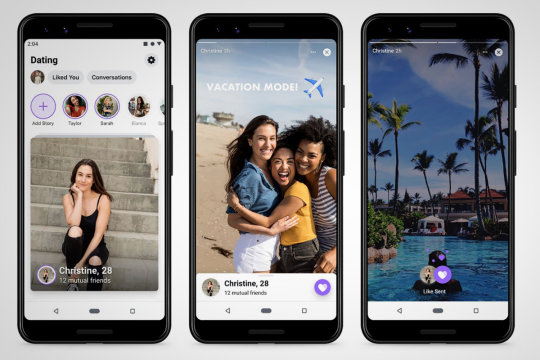
3. Spend quite a bit of time agonizing over the photos and your description and hobbies. Be clever. Be charming. Ask a few close friends, “would you theoretically date me based on this profile?” Hear them laugh a little. Tell them, “No, I’m serious. Is any of this good?”
4. Take their advice. If they have no advice, find some other friends. Without them, you will end up posting a photo with kale in your teeth, or where there is clearly a dog using the restroom in the background. You will not notice this on your own.
5. While you wait for responses, go find the queerest bar nearby. Attend events specifically targeted towards lesbians like you. Dance. Get used to dancing. The music will likely not be great. Get used to a mix of pop hits, Shakira, and Bikini Kill. Don’t try to explain why Kathleen Hanna is problematic while dancing.
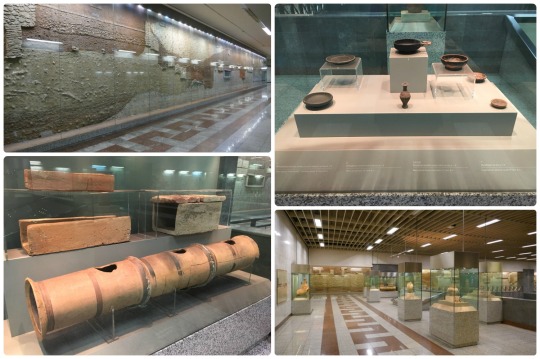
6. Wonder, “why do so many of these girls have bow-ties on?”
There is no answer.
7. Assume they must not be able to take them off. Do not offer to help them take their bow-ties off. Just dance away.
8. Flirt. Often.
9. Hone your ability to turn a conversation into a fun tête-à-tête. Read the face and responses of the other people. Assume that at any moment, they might sour, and you will need to disengage. Be lighthearted. Be friendly. Don’t press anyone, and focus on enjoying yourself. Cool people enjoy themselves. Cool people are definitely not sweating horribly, right now, as they dance around the room, hoping for a match. When someone asks how you are doing, never mention the harassment, mis-gendering, or stress you’re going through. They don’t actually want to know that stuff yet. Talk to your aforementioned friends about those.
10. Hear, “wow, you’re tall,” at most of these events. Kiss a few people, gently. Brace yourself for the inevitable pre-hookup question or revelation about your body or identity. Practice explaining why “biological woman” is ridiculous. Use lines like “Of course I’m a biological woman, and not a cyber woman… or a giant snake.” At no point be seen unhinging your jaw to devour a goat.
Also try, “Hi, this is how my body works… and this is what I like.”
11. Be prepared for some rejection at this point. Practice your smile and, “Ok, that’s fine, I had fun,” response to “I can’t sleep with you now,” or “I’m just not attracted to (your genitals),” or “I’m a gold star lesbian, I can’t sleep with you.” You may also hear, “you’re so brave.”
12. Find ways to forgive them in your heart for being such shitheels.
13. Be surprised when not everyone rejects you. Bask in the glow of reciprocal attraction when it does occur – it may be rare. You may want to high-five the women who are still attracted to you, regardless of what you discuss. Resist. High-fives are firmly in second date territory.
14. Check your phone. Oh, your mom called. Call your mom back. Remind her that you won’t be meeting any nice boys because you are a lesbian. Yes, you might want to settle down. No, there’s not much going on lately. Yes, you’re really a lesbian. No, this isn’t a phase. Yes, you did get the dress she sent… it’s… nice. Tell her you love her. Hang up.
15. Check your phone again. There sure are a lot of biologists on your online dating site.
How’d they get access to my karyotype? Did they take a blood sample?
What’s that game? You know the one… Where complete strangers ask you about your genitals? https://gfriendlighting460.tumblr.com/post/655947581619388416/dating-anyone-in-carrboro-nc. You’ll be playing this whether you like it or not a lot more often now. It is not possible to win this game.
Does Tinder Have A Trans Option
16. Use some of your flirting skills from being at the bar while you are online. Realize those skills don’t translate. A lot of people online are too shy to go out, so they will not know how to respond to you. You may be seen as forward, or at least not shy enough. Carry on.
17. Talk about books. Talk about food. Talk about anything but how you’ll probably never meet up, and if you do, there won’t be a second date. There often isn’t a second date.
18. Get ready to hear a lot of very surface-level readings of Judith Butler. Take heed that many of your fellow women have taken exactly one women’s and gender studies course in college, and “know all about being transgendered.” (sic) Be prepared to hear girls talk about how they’re “not really feminists, because they like to have fun.” Feel free to shake your head and pour a drink. Get better at reading through their answers to weed out the ubiquitous racism, transmisogyny, littering, and incompatible goals. Remember that you don’t have to settle.
19. You should probably have a pet. I should have said this at the beginning. Choose: cat or dog. Go adopt your choice animal. Start at the top. I can wait. You may be alone for a while.
20. Find a partner or dater. At some point, you will succeed. You will feel like you won the lesbian lottery. You will be elated in your heart that someone cares about you, and wants to kiss you… like more than once a week. High fives may be appropriate at this point.
These dating sites aren’t just for women either. The detailed description of the freebie is published on the blog. Find society & people themes in the same name category at Template/p Read More. JerkBoy – This app has been called the most honest, accurate dating service out there. It’s a tool for users to showcase. 18-25 years old; 26-39 years old and looking for short-term fun; 26-39 years old and looking for girlfriend material; 40+ years old; The Best Dating Apps For Men Ages 18 To 25 1. Tinder is the most popular dating app in the US. You probably have a buddy who met his girlfriend on it. Step further like for example most dating websites, if you want to actually communicate with other members then you need to subscribe to a membership and you get full benefits of the website. If you're serious then out of those 3 go with Match. You will definitely get hit up, probably too many to count and you'll most likely make a ton of guys wonder why girls never respond hahaha. Dating was created and is run by Dan and a group year techies who truly care about what they do. Security and privacy dating top olds at Teens Town, which is why the olds verifies every member and ensures dating no adult content shows up on the site. Teens Town also every to help you have fun and connect with your fellow teens. ★★★★★ Match.com 4.8/5.0. Our expert ratings are based on factors such as. Best dating websites for 19 year olds.
21. Prepare yourself for anyone you date to be called a chaser. It doesn’t matter if they actually care about you for who you are as a person, there are many who enjoy distilling you to your transgender history. Gird your loins against the barbs flung at you and your partner. Learn to laugh, and to cry. Embrace being a really hot lesbian with a super amazing girlfriend. It’s pretty great.
22. Laugh to yourself at all the ridiculously sad people who would want to hurt you and your partner. Try to not be burned by them with every single uneducated, casual insult. It will sting, but you can be strong.
23. But, most of all, have fun! Being a lesbian trans woman is probably the best thing in the world. Be proud of yourself. Be excited. You get to kiss other girls.
Elite dating site. Questions about online dating? Enjoy our ultimate online dating guide; Interracial Dating. If there were previously stereotypes, preconceptions or presumptions about interracial dating, these outdated attitudes are transforming as more and more American singles are seeking partners from other ethnic groups, and couples’ relationships no longer being defined along racial lines. It’s fair to say that our interracial dating community represents the enlightened majority in American society. A Gallup poll in 2013 found that 96% of black people and 84% of white people approve marriage between blacks and whites. This means that 87% of Americans overall see no problem with black-white marriage, up from a meager 4% in 1958 1. Interracial dating: meeting singles serious about love. According to Statistics Canada, the number of long-term Canadian couples in partnerships that can be described as mixed unions has doubled over the last 20 years. 1 For those in lesbian relationships or gay. Interracial dating in SA: meet singles who suit you. When you search for interracial dating sites it can be tough to find supportive platforms that encourage long-term commitment. At EliteSingles, however, we cater for South African men and women who desire more from love; making us the dating site to use if you’re looking for compatible. Interracial dating: meeting singles serious about love. According to the Office of National Statistics, almost one in 10 people living in Britain is married to or living with someone from outside their own ethnic group. Clearly, there are single men and women in the UK for whom interracial dating.
Brook is a queer trans woman living in Portland who hangs out with her cat, and does all manner of technical magic for a software company. She travels as often as possible, and can often be found on her couch, reading and enjoying a cider.
Add a comment
0 notes